English Compositions

Short Essay on Our Culture Our Identity [100, 200, 400 Words] With PDF
Culture is the most significant identity of human beings. So, knowing own culture is very much important. In this lesson today, you will learn how to write an essay on the popular phrase: Our Culture Our Identity.

Short Essay on Our Culture Our Identity in 100 Words
Culture plays an important role in our lives. Every person is unique and different from the other. It is mainly because of their culture. People belong to several nations and communities. So their language changes, their dresses are different, their habits also do not match with each other. All of these happen because we belong to several cultures.
Our culture builds us to be complete human beings. It is our identity. Culture affects our behaviour, manners, and style. It includes the nature we have. Also, it comes from our family background, the teachings we receive and the moral education that we are given. If we are well cultured, then everyone will praise us.
Short Essay on Our Culture Our Identity in 200 Words
The line ‘ Our culture our identity’ comes from the country Nepal. Nepal is a land of diversity. It has various types of flora, fauna, festivals, food, dresses, and culture. But now this is applicable to every country living on Earth. Culture is a part of our identity. It builds our character and manners. If we are cultured, then we are praised by all.
Culture also includes language and our behaviour. It also contains our social activities. Culture differs from person to person. It happens due to different nations. We grow up under a definite culture. It affects our moral development. Culture comes both from our family and also from our surroundings.
Culture Whatever we believe comes from our culture. It remains throughout our life. Nowadays, several people are going to different countries. They study or work abroad. Then the culture of that foreign land affects the person. He mixes the foreign culture with his own. Everything in our life is controlled by culture. It makes us what we are. Our wishes are also part of our culture.
When we succeed in our life, our culture is praised. Culture includes our religions and festivals. Durga puja is now an important festival in foreign countries. All know about Durga Puja. So this helps the Hindu religion and Indian culture get more popular. We live for our culture. Our culture is our pride.
Short Essay on Our Culture Our Identity in 400 Words
We are Indians and we are proud of our nation. We are proud of its people, culture, diversity, independence, nature, and surroundings. What is important for us is the culture we have. Culture makes our identity. As Indians, we have a specific culture. It is different from what others have.
Our culture separates us from others. It is something that makes us unique. It teaches the right and the wrong. We start learning about our culture from childhood. So that we can forever remember it. So culture is our strength. If we follow our culture and its rules, then we will be praised forever.
The identity of a person is formed by his culture. Whatever we believe comes from that. If we have plans for the future, then our culture helps us in it. When we work for our nation, our culture is praised. Every culture has its own value. We cannot forget that. As we grow up, we have to maintain those values. It helps to grow our lives. It makes our lives more beautiful.
These values are different from one another. Every country has its own culture. It has its own values and morals. We see different habits, people, their practices, festivals, foods, clothes, and language. All of these happen because of culture. Our behaviour and manners are also important. It shows how beautiful our culture is.
We are taught about our culture from our childhood. Parents always teach their children about the cultures of their country. Even a small society has a separate rule. Culture comes from our family. If we are well behaved, then people praise our family background. Our grandparents also give us lessons on our culture. They are old and wise.
They know a lot about the culture of the nation. Our environment plays an important role in building us as well. If we have a bad surrounding, then it affects us. We do not learn good manners, we become rough, and also go the wrong way. It becomes very difficult for us to adjust if our culture is not good. So culture creates good and strong personalities.
The line ‘our culture our identity’ comes from Nepal. Nepal is a land of diversity. It has a different language, nature, clothes, food, festivals and people. But now this is applicable to all countries. Culture is very important for us. We must know about it. It makes us proud of what we have. A cultured person is always the best human being on Earth.
In this session today, you have learned how you can write essays on the popular topic: Our Culture Our Identity. In this lesson, I have tried to discuss the topic from a very easy perspective to make it easier to understand for all kinds of students. If you still have any doubts regarding this context, post them in the comment section below.
Join us on telegram to get the latest updates on our upcoming sessions. Thank you for being with us. See you again, soon.
Essays about Culture and Identity: 9 Examples And Prompts
Writing essays about culture and identity will help you explore your understanding of it. Here are examples that will give you inspiration for your next essay.
Culture can refer to customs, traditions, beliefs, lifestyles, laws, artistic expressions, and other elements that cultivate the collective identity. Different cultures are established across nations, regions, communities, and social groups. They are passed on from generation to generation while others evolve or are abolished to give way to modern beliefs and systems.
While our cultural identity begins at home, it changes as we involve ourselves with other groups (friends, educational institutions, social media communities, political groups, etc.) Culture is a very relatable subject as every person is part of a culture or at least can identify with one. Because it spans broad coverage, there are several interesting cultural subjects to write about.
Our culture and identity are dynamic. This is why you may find it challenging to write about it. To spark your inspiration, check out our picks of the best culture essays.
| IMAGE | PRODUCT | |
|---|---|---|
| Grammarly | ||
| ProWritingAid |
1. Sweetness and Light by Matthew Arnolds
2. how auto-tune revolutionized the sound of popular music by simon reynolds, 3. how immigration changes language by john mcwhorter, 4. the comfort zone: growing up with charlie brown by jonathan franzen, 5. culture and identity definition by sandra graham, 6. how culture and surroundings influence identity by jeanette lucas, 7. how the food we eat reflects our culture and identity by sophia stephens, 8. identity and culture: my identity, culture, and identity by april casas, 9. how america hinders the cultural identity of their own citizens by seth luna, 1. answer the question, “who am i”, 2. causes of culture shock, 3. your thoughts on dystopia and utopia, 4. gender inequality from a global perspective, 5. the most interesting things you learned from other cultures, 6. the relationship between cultural identity and clothes, 7. describe your culture, 8. what is the importance of honoring your roots , 9. how can a person adapt to a new culture, 10. what artistic works best express your country’s culture, 11. how has social media influenced human interaction, 12. how do you protect the cultures of indigenous peoples, 13. are k-pop and k-drama sensations effectively promoting korea’s culture , 14. what is the importance of cultural diversity.
“… [A]nd when every man may say what he likes, our aspirations ought to be satisfied. But the aspirations of culture, which is the study of perfection, are not satisfied, unless what men say, when they may say what they like, is worth saying,—has good in it, and more good than bad.”
Arnolds compels a re-examination of values at a time when England is leading global industrialization and beginning to believe that greatness is founded on material progress.
The author elaborates why culture, the strive for a standard of perfection, is not merely driven by scientific passions and, more so, by materialistic affluence. As he esteems religion as “that voice of the deepest human experience” to harmonize men in establishing that ideal society, Arnolds stresses that culture is the effort to “make reason and the will of God prevail” while humanizing gained knowledge to be society’s source of “sweetness and light.”
“Few innovations in sound production have been simultaneously so reviled and so revolutionary. Epoch-defining or epoch-defacing, Auto-Tune is indisputably the sound of the 21st century so far.”
Reynolds shows how Auto-Tune has shaped a pop music genre that has cut across cultures. The article maps out the music landscape Auto-Tune created and examines its impact on the culture of song productions and the modern taste for music. While the author debunks accusations that Auto-Tune destroyed the “natural” process of creating music, he also points out that the technology earned its reverence with big thanks to society’s current custom of using technology to hide blemishes and other imperfections.
Looking for more? Check out these essays about culture shock .
“… [T]he heavy immigration that countries like Italy are experiencing will almost certainly birth new kinds of Italian that are rich with slang, somewhat less elaborate than the standard, and… widely considered signs of linguistic deterioration, heralding a future where the “original” standard language no longer exists.”
American linguist McWhorter pacifies fears over the death of “standard” languages amid the wave of immigration to Europe. On the contrary, language is a vital expression of a culture, and for some, preserving is tantamount to upholding a cultural standard.
However, instead of seeing the rise of new “multiethnolects” such as the Black English in America and Kiezdeutsch in Germany as threats to language and culture, McWhorter sees them as a new way to communicate and better understand the social groups that forayed these new languages.
“I wonder why “cartoonish” remains such a pejorative. It took me half my life to achieve seeing my parents as cartoons. And to become more perfectly a cartoon myself: what a victory that would be.”
This essay begins with a huge fight between Franzen’s brother and father to show how the cultural generation gap sweeping the 60s has hit closer to home. This generation gap, where young adults were rejecting the elders’ old ways in pursuit of a new and better culture, will also be the reason why his family ends up drifting apart. Throughout the essay, Franzen treads this difficult phase in his youth while narrating fondly how Peanuts, a pop culture icon at the time, was his source of escape.
“…Culture is… your background… and Identity is formed where you belong to… Leopold Sedar Senghor and Shirley Geok-Lin Lim both talks about how culture and identity can impact… society…”
In this essay, Graham uses “To New York” by Senghor and “Learning To Love America” by Lim as two pieces of literature that effectively describe the role of culture and identity to traveling individuals.
The author refers to Sengho’s reminder that people can adapt but must not forget their culture even if they go to a different place or country. On the other hand, Lim discusses immigrants’ struggle to have double identities.
“Culture is something that surrounds all of us and progress to shape our lives every day… Identity is illustrated as the state of mind in which someone or something distinguishes their own character traits that lead to determining who they really are, what they represent.”
Lucas is keen on giving examples of how his culture and surroundings influence an individual’s identity. She refers to Kothari’s “If you are what you eat, then what am I?” which discusses Kothari’s search for her identity depending on what food she eats. Food defines a person’s culture and identity, so Kothari believes that eating food from different countries will change his identity.
Lucas also refers to “Down These Mean Streets” by Piri Thomas, which argues how different cultural and environmental factors affect us. Because of what we encounter, there is a possibility that we will become someone who we are not.
“What we grow is who we are. What we buy is who we are. What we eat is who we are.”
Stephens’ essay teaches its readers that the food we grow and eat defines us as a person. She explains that growing a crop and harvesting it takes a lot of effort, dedication, and patience, which mirrors our identity.
Another metaphor she used is planting rice: it takes skills and knowledge to make it grow. Cooking rice is more accessible than cultivating it – you can quickly cook rice by boiling it in water. This reflects people rich in culture and tradition but who lives simpler life.
“Every single one has their own unique identity and culture. Culture plays a big role in shaping your identity. Culture is what made me the person I am today and determines who or what I choose to associate myself with.”
Casas starts her piece by questioning who she is. In trying to learn and define who she is, she writes down and describes herself and her personality throughout the essay. Finally, she concludes that her culture is a big part of her identity, and she must understand it to understand herself.
“When it comes to these stereotypes we place on each other, a lot of the time, we succumb to the stereotypes given to us. And our cultural identity is shaped by these expectations and labels others give us. That is why negative stereotypes sometimes become true for a whole group or community.”
In this essay, Luna talks about how negative stereotyping in the United States led to moral distortion. For example, Americans are assumed to be ignorant of other countries’ cultures, making it difficult to understand other people’s cultures and lifestyles.
She believes that stereotyping can significantly affect an individual or group’s identity. She suggests Americans should improve their intellectual competence by being sensitive to other people’s cultures.
14 Prompts on Essays about Culture and Identity
You can discuss many things on the subject of culture and identity. To give you a starting point, here are some prompts to help you write an exciting essay about culture.
If you are interested in learning more, check out our essay writing tips and our round-up of the best essay checkers .
Understanding your personality is vital since continuous interaction with others can affect your personality. Write about your culture and identity; what is your personality? How do you define yourself? Everyone is unique, so by writing an essay about who you are, you’ll be able to understand why you act a certain way and connect with readers who have the same values.
Here’s a guide on writing a descriptive essay to effectively relay your experience to your readers.
Sometimes, people need to get out of their comfort zone and interact with other individuals with different cultures, beliefs, or traditions. This is to broaden one’s perspective about the world. Aside from discussing what you’ve learned in that journey, you can also focus on the bits that shocked you.
You can talk about a tradition or value that you found so bizarre because it differs from your culture. Then add how you processed it and finally adapted to it.

Dystopia and Utopia are both imagined worlds. Dystopia is a world where people live in the worst or most unfavorable conditions, while Utopia is the opposite.
You can write an essay about what you think a Dystopian or Utopian world may look like, how these societies will affect their citizens, etc. Then, consider what personality citizens of each world may have to depend on the two worlds’ cultures.
Today, more and more people are fighting for others to accept or at least respect the LGBTQ+ community. However, countries, territories, and religions still question their rights.
In your essay, you can talk about why these institutions react the way they do and how culture dictates someone’s identity in the wrong way. Before creating your own, feel free to read other essays and articles to learn more about the global gender inequality issue.
The world has diverse cultures, traditions, and values. When you travel to a new place, learning and writing about your firsthand experiences with unique cultures and rituals will always be an interesting read.
In this prompt, you’ll research other cultures and how they shaped their group’s identity. Then, write about the most exciting aspects you’ve learned, why you found them fascinating, and how they differ from your culture.
Those proud of their culture will wear clothes inspired by them. Some wear the same clothes even if they aren’t from the same culture. The debate over cultural appropriation and culture appreciation is still a hot topic.
In this essay, you may start with the traditions of your community or observances your family celebrates and gathers for. Then, elaborate on their origins and describe how your community or family is preserving these practices.
Learning about your roots, ancestors, and family cultures can help strengthen your understanding of your identity and foster respect for other cultures. Explore this topic and offer examples of what others have learned. Has the journey always been a positive experience? Delve into this question for an engaging and interesting essay.
When a person moves country, it can be challenging to adapt to a new culture. If there are new people at work or school, you can interview them and ask how they are coping with their new environment. How different is this from what they have been used to, and what unique traditions do they find interesting?
Focus on an art piece that is a source of pride and identity to your country’s culture, much like the Tinikling of the Philippines or the Matryoshka dolls of Russia. Explore its origins and evolution up to its current manifestation and highlight efforts that are striving to protect and promote these artistic works.
The older generation did not have computers in their teen years. Ask about how they dated in their younger years and how they made friends. Contrast how the younger generation is building their social networks today. Write what culture of socialization works better for you and explain why.
Take in-depth navigation of existing policies that protect indigenous peoples. Are they sufficient to serve these communities needs, and are they being implemented effectively? There is also the challenge of balancing the protection of these traditions against the need to protect the environment, as some indigenous practices add to the carbon footprint. How is your government dealing with this challenge?
A large population is now riding the Hallyu or the Korean pop culture, with many falling in love with the artists and Korea’s food, language, and traditional events. Research how certain Korean films, TV series, or music have effectively attracted fans to experience Korea’s culture. Write about what countries can learn from Korea in promoting their own cultures.
Environments that embrace cultural diversity are productive and innovative. To start your essay, assess how diverse your workplace or school is. Then, write your personal experiences where working with co-workers or classmates from different cultures led to new and innovative ideas and projects. Combine this with the personal experiences of your boss or the principal to see how your environment benefits from hosting a melting pot of cultures.
If you aim for your article to effectively change readers’ perspectives and align with your opinion, read our guide to achieving persuasive writing .

- _Grade VIII
- _ _Social Studies
- _ _(Grade XI- New Course)
- _ _ _Language Development
- _ _ _Literary Studies
- _ _ _ _Short Stories
- _ _ _ _Poems
- _ _(Grade XII- New Course)
- _Basic Level
- Moral Stories
- General Knowledge
- Information
Monday, October 29, 2018

Our Culture Is Our Identity (Essay)

12 comments:

Impressive. But there are some space for you to still work in.👌
It is really helpful I like it....
dherai dherai ramro lekhnu vaxa sir hjr
Look at that which you have read for each of the details of your essay and work out tips on how to discuss it is likely to words, or in an even more informative way. writing paper service
Nice post! This is a very nice blog that I will definitively come back to more times this year! Thanks for informative post. professional essay writers
Everyone has heard the word "Write what you know."Personal narrative essays allow you to take this advice to the extreme, since the idea of one of these simple essays is to write about your own experience. paper writing service
Therapists have asserted that there are sure culture explicit practices and certain all inclusive standards of conduct among people and comprehend whether it is feasible to depict practices that are culture explicit or intra-social and those that are widespread or between social. East Asian beauty trends
Find out about the normal highlights of the essay composing style just as gain proficiency with the eccentricities of the essay type you ought to compose. Work out the plan of your essay type composing and follow it when composing an essay. PhD Thesis Writing Service
which you have shared here. I liked your way to express your views in this article. Thank you for sharing this blog with us thesis writing services UK

I can't entirely agree with your message about the need to embrace our cultural heritage and celebrate the diversity of our country. It is essential to remember our roots and preserve our unique identity in a world that is becoming increasingly globalized. By: Cheap Dissertation Writing Service
This is possible only by the knowledge and use of computer Such a great essay it really helps me too for more essays and information dissertation writing service
Å finne den rette Kevlar skjorte er som å oppdage den perfekte reisefølget – det handler om komfort, beskyttelse og å uttrykke din unike stil på veien. Denne kolleksjonen ser ut til å klare alt, og balanserer sikkerhetsfunksjoner med et imponerende utvalg av design som virkelig faller i smak til enhver rytter. Kudos for å holde syklister trygge samtidig som de ser uanstrengt kule ut på eventyrene sine!
Email Subscription
Enter your email address:
Delivered by FeedBurner
Subscribe Our Youtube Channel
Total pageviews.
- Privacy Policy
- Terms and conditions
Popular Posts

Copyright (c) 2021 Surya Xetri
Cultural Identity Essay
27 August, 2020
12 minutes read
Author: Elizabeth Brown
No matter where you study, composing essays of any type and complexity is a critical component in any studying program. Most likely, you have already been assigned the task to write a cultural identity essay, which is an essay that has to do a lot with your personality and cultural background. In essence, writing a cultural identity essay is fundamental for providing the reader with an understanding of who you are and which outlook you have. This may include the topics of religion, traditions, ethnicity, race, and so on. So, what shall you do to compose a winning cultural identity essay?

Cultural Identity Paper: Definitions, Goals & Topics

Before starting off with a cultural identity essay, it is fundamental to uncover what is particular about this type of paper. First and foremost, it will be rather logical to begin with giving a general and straightforward definition of a cultural identity essay. In essence, cultural identity essay implies outlining the role of the culture in defining your outlook, shaping your personality, points of view regarding a multitude of matters, and forming your qualities and beliefs. Given a simpler definition, a cultural identity essay requires you to write about how culture has influenced your personality and yourself in general. So in this kind of essay you as a narrator need to give an understanding of who you are, which strengths you have, and what your solid life position is.
Yet, the goal of a cultural identity essay is not strictly limited to describing who you are and merely outlining your biography. Instead, this type of essay pursues specific objectives, achieving which is a perfect indicator of how high-quality your essay is. Initially, the primary goal implies outlining your cultural focus and why it makes you peculiar. For instance, if you are a french adolescent living in Canada, you may describe what is so special about it: traditions of the community, beliefs, opinions, approaches. Basically, you may talk about the principles of the society as well as its beliefs that made you become the person you are today.
So far, cultural identity is a rather broad topic, so you will likely have a multitude of fascinating ideas for your paper. For instance, some of the most attention-grabbing topics for a personal cultural identity essay are:
- Memorable traditions of your community
- A cultural event that has influenced your personality
- Influential people in your community
- Locations and places that tell a lot about your culture and identity
Cultural Identity Essay Structure
As you might have already guessed, composing an essay on cultural identity might turn out to be fascinating but somewhat challenging. Even though the spectrum of topics is rather broad, the question of how to create the most appropriate and appealing structure remains open.
Like any other kind of an academic essay, a cultural identity essay must compose of three parts: introduction, body, and concluding remarks. Let’s take a more detailed look at each of the components:
Introduction
Starting to write an essay is most likely one of the most time-consuming and mind-challenging procedures. Therefore, you can postpone writing your introduction and approach it right after you finish body paragraphs. Nevertheless, you should think of a suitable topic as well as come up with an explicit thesis. At the beginning of the introduction section, give some hints regarding the matter you are going to discuss. You have to mention your thesis statement after you have briefly guided the reader through the topic. You can also think of indicating some vital information about yourself, which is, of course, relevant to the topic you selected.
Your main body should reveal your ideas and arguments. Most likely, it will consist of 3-5 paragraphs that are more or less equal in size. What you have to keep in mind to compose a sound ‘my cultural identity essay’ is the argumentation. In particular, always remember to reveal an argument and back it up with evidence in each body paragraph. And, of course, try to stick to the topic and make sure that you answer the overall question that you stated in your topic. Besides, always keep your thesis statement in mind: make sure that none of its components is left without your attention and argumentation.
Conclusion
Finally, after you are all finished with body paragraphs and introduction, briefly summarize all the points in your final remarks section. Paraphrase what you have already revealed in the main body, and make sure you logically lead the reader to the overall argument. Indicate your cultural identity once again and draw a bottom line regarding how your culture has influenced your personality.
Best Tips For Writing Cultural Identity Essay
Writing a ‘cultural identity essay about myself’ might be somewhat challenging at first. However, you will no longer struggle if you take a couple of plain tips into consideration. Following the tips below will give you some sound and reasonable cultural identity essay ideas as well as make the writing process much more pleasant:
- Start off by creating an outline. The reason why most students struggle with creating a cultural identity essay lies behind a weak structure. The best way to organize your ideas and let them flow logically is to come up with a helpful outline. Having a reference to build on is incredibly useful, and it allows your essay to look polished.
- Remember to write about yourself. The task of a cultural identity essay implies not focusing on your culture per se, but to talk about how it shaped your personality. So, switch your focus to describing who you are and what your attitudes and positions are.
- Think of the most fundamental cultural aspects. Needless to say, you first need to come up with a couple of ideas to be based upon in your paper. So, brainstorm all the possible ideas and try to decide which of them deserve the most attention. In essence, try to determine which of the aspects affected your personality the most.
- Edit and proofread before submitting your paper. Of course, the content and the coherence of your essay’s structure play a crucial role. But the grammatical correctness matters a lot too. Even if you are a native speaker, you may still make accidental errors in the text. To avoid the situation when unintentional mistakes spoil the impression from your essay, always double check your cultural identity essay.
A life lesson in Romeo and Juliet taught by death
Due to human nature, we draw conclusions only when life gives us a lesson since the experience of others is not so effective and powerful. Therefore, when analyzing and sorting out common problems we face, we may trace a parallel with well-known book characters or real historical figures. Moreover, we often compare our situations with […]

Ethical Research Paper Topics
Writing a research paper on ethics is not an easy task, especially if you do not possess excellent writing skills and do not like to contemplate controversial questions. But an ethics course is obligatory in all higher education institutions, and students have to look for a way out and be creative. When you find an […]

Art Research Paper Topics
Students obtaining degrees in fine art and art & design programs most commonly need to write a paper on art topics. However, this subject is becoming more popular in educational institutions for expanding students’ horizons. Thus, both groups of receivers of education: those who are into arts and those who only get acquainted with art […]

Short Essay: Our Culture Our Pride
Writing a short essay on “Our Culture, Our Pride” is a meaningful way to reflect on and celebrate the unique aspects of one’s cultural heritage. This topic invites discussion on the significance of culture in shaping individual and collective identities, and how cultural pride can contribute to a more inclusive and respectful society. Here are structured guidelines on how to craft such an essay effectively.
Table of Contents
Introduction
Begin your essay with a compelling introduction that draws readers into the importance of culture in our lives. You might start with a personal anecdote that shows the impact of culture on your daily life or a broad statement about the role of culture in shaping societies. Define what you mean by “culture” — whether it’s customs, traditions, language, art, or values. Introduce the idea of cultural pride and why it’s crucial for maintaining a vibrant and diverse world. End your introduction with a thesis statement that outlines the specific aspects of culture you will discuss and how they foster pride and unity among individuals.
The Richness of Cultural Heritage
Cultural pride and identity, the role of culture in promoting unity and diversity.
For the third paragraph, argue the broader significance of cultural pride in promoting social cohesion and diversity. Discuss how understanding and celebrating different cultures can lead to greater empathy and cooperation among diverse groups. You might want to touch on:
Propose actions or attitudes that can foster an environment where all cultures are respected and celebrated, such as multicultural education, inclusive policies, and community events that showcase different cultural traditions.
Conclude your essay by summarizing the key points about the importance of maintaining cultural pride. Reaffirm the value of your own cultural heritage and its role in shaping a vibrant, diverse society. End with a call to action, encouraging others to explore and respect diverse cultural landscapes as a pathway to a more harmonious world.
Our Culture Our Pride Example #1
India has a rich cultural heritage that spans thousands of years. Our culture is diverse and unique, and it is a source of pride for our nation. The ancient Indian civilization has contributed significantly to the world in the fields of science, mathematics, philosophy, and literature. The Indus Valley Civilization is one of the oldest civilizations in the world, dating back to 2500 BCE. It is a testament to the rich cultural heritage of India, which has been preserved and passed down from generation to generation. Indian history is a reflection of its culture, and it is essential to preserve it for future generations.
Cultural traditions such as music, dance, and cuisine are celebrated and preserved throughout the country. Indian music is one of the oldest forms of music in the world, and it has a unique style that is different from Western music. Indian classical music has been passed down from generation to generation, and it is still popular today. Indian dance is also a reflection of our culture, and it is an essential part of our cultural heritage. Various dance forms such as Bharatanatyam, Kathak, and Kuchipudi are popular across the country. Indian cuisine is also diverse and unique, and it varies from region to region. The spices and herbs used in Indian cuisine are known for their medicinal properties and have been used for centuries in Ayurvedic medicine.
In conclusion, our culture is our identity and pride, and it is essential to preserve and celebrate it. India has a rich cultural heritage that spans thousands of years, and it is a source of pride for our nation. Cultural traditions such as music, dance, and cuisine are celebrated and preserved throughout the country. By embracing and promoting our culture, we can preserve our national identity and promote unity among diverse communities. As a nation, we should take pride in our culture and heritage and pass it down to future generations.
Our Culture Our Pride Example #2
India is a land of diverse cultures, traditions, and religions. The country’s rich heritage is deeply rooted in its history and has been passed down through generations. From the majestic Himalayas in the north to the lush green forests in the south, India is a melting pot of cultures that has thrived for centuries. The Indian culture is a source of pride for many Indians, and it is celebrated across the world for its vibrancy and diversity. In this essay, we will explore the various aspects of Indian culture and how it has become a source of pride for the nation.
One of the most remarkable aspects of Indian culture is its diversity. Cultural practices and beliefs vary greatly across different regions and communities in India. For example, the tradition of arranged marriages is prevalent in some parts of the country, while in others, love marriages are more common. Similarly, the way festivals are celebrated, the food that is eaten, and the clothes that are worn vary from region to region. Despite these differences, Indian culture has a unifying force that brings people together. The country’s national festivals, such as Diwali and Holi, are celebrated with great fervor across the nation, regardless of religion or region.
In conclusion, Indian culture is a source of pride for the nation. It is rich, diverse, and steeped in history and tradition. The country’s cultural practices and beliefs vary greatly across different regions and communities, making it a unique blend of different cultures. Indian culture is celebrated globally, and its cuisine, music, dance, festivals, and spiritual practices have gained popularity across the world. Despite the differences, Indian culture has a unifying force that brings people together and spreads the message of love and unity. The Indian culture is truly something to be proud of.
Our Culture Our Pride Example #3
India is a land of diversity, and its culture is a reflection of its rich heritage. The country is known for its unity in diversity, which is evident in its various religions, languages, and traditions. India has a unique identity that distinguishes it from other nations in the world. Its diverse culture is the result of the amalgamation of different cultures over thousands of years. The country’s culture is a source of pride for all its citizens and is celebrated worldwide. In this essay, we will explore India’s diverse culture and why it is essential to preserve and promote it.
Traditional art forms such as dance, music, and handicrafts showcase India’s rich cultural heritage. Indian classical music is renowned worldwide for its intricate rhythms and melodies. Similarly, Indian classical dance forms such as Bharatanatyam, Kathak, and Kuchipudi are known for their grace and elegance. Indian handicrafts such as pottery, textiles, and jewelry are also unique and reflect the country’s rich cultural heritage. Each state in India has its unique handicrafts, which are a source of pride for the people of that state.
The Indian government has taken several initiatives to promote Indian culture, such as organizing cultural festivals, setting up cultural centers abroad, and promoting Indian cuisine and handicrafts. Various non-governmental organizations (NGOs) are also working towards the preservation of Indian culture. They organize workshops, seminars, and cultural events to raise awareness about India’s rich cultural heritage.
In conclusion, India’s diverse culture is a source of pride for all its citizens. It is a reflection of the country’s rich heritage and distinguishes India from other nations in the world. Traditional art forms, such as dance, music, and handicrafts, showcase India’s cultural diversity. It is essential to preserve and promote Indian culture to ensure that it continues to thrive and receives global recognition. By doing so, we can ensure that our culture remains our pride.
Final Writing Tips
About mr. greg.
Academic Test Guide
Essay on Our Culture is Our Pride for Students
We are Sharing an Essay on Our Culture is Our Pride in English for students and children. In this article, we have tried our best to provide a short Our Culture is Our Pride Essay in 100, 150, 200, 300, and 500 words.
( Essay-1 ) 10 Lines Short Essay on Our Culture is Our Pride in English ( 150 words )
1 In the mosaic of humanity, our culture shines as a vibrant jewel.
2 It’s the symphony of traditions, languages, and customs that make us who we are.
3 Our cultural heritage is a treasure trove of wisdom and creativity.
4 Like a compass, our culture guides us through life’s journey with values and traditions.
5 It’s the kaleidoscope of colors that paints the canvas of our shared experiences.
6 Our culture is a tapestry woven with threads of resilience and unity.
7 Each tradition, dance, and cuisine tells the story of our collective journey.
8 Celebrating our culture is an ode to the resilience and spirit of humanity.
9 It’s the mosaic of diversity that forms the bedrock of our global community.
10 Our culture is not just a part of us; it’s the heartbeat of our shared humanity.
Essay on Culture
( Essay-2 ) Our Culture is Our Pride Essay Writing for students in 250 words
Our culture is not just a collection of customs and traditions; it’s the beating heart of humanity, pulsating with the rhythm of our shared experiences and values. It’s the language we speak, the food we savor, and the stories we tell. Our culture defines who we are and binds us together as one human family.
Embedded within our culture are the timeless wisdom and knowledge passed down from our ancestors. It’s the songs sung by our grandmothers, the dances performed by our fathers, and the recipes handed down through generations. These cultural treasures are the threads that connect us to our past and guide us into the future.
Our culture is our pride because it celebrates our diversity and reminds us of the beauty of our shared humanity. Through the celebration of our culture, we honor the resilience and strength of our ancestors who overcame adversity and preserved their traditions against all odds.
Moreover, our culture is a bridge that connects us to others, transcending borders, languages, and ideologies. It’s a language of love and understanding that speaks to the soul and fosters empathy and compassion.
In essence, our culture is our pride because it reflects the essence of our humanity – our hopes, dreams, and aspirations. Let us cherish our culture as the precious gift that it is and share its beauty with the world.
( Essay-3 ) Essay on Our Culture is Our Pride in English ( 500 words )
Culture is like a colorful rainbow that makes our world beautiful and vibrant. It’s the special way we do things, the stories we tell, and the songs we sing. Our culture is what makes us unique and connects us to our ancestors and each other. In this essay, we’ll explore why our culture is our pride and why celebrating it is so important.
Firstly, our culture is our identity. Just like our fingerprints are unique to us, our culture is unique to our community or family. It’s the traditions we follow, the food we eat, and the clothes we wear. Our culture tells others who we are and where we come from, helping us feel a sense of belonging and pride in who we are.
Secondly, our culture is our heritage. Imagine a treasure chest filled with precious jewels – that’s what our cultural heritage is like. It’s the wisdom, stories, and traditions passed down to us from our parents, grandparents, and ancestors. These treasures remind us of our roots and the journey our ancestors took to get us where we are today.
Next, our culture is our language. Just as birds have their songs, we have our language to communicate with each other. Our language is more than just words – it’s a melody that connects us to our past and helps us express our thoughts, feelings, and dreams. Speaking our language is like singing a song that has been passed down through generations, keeping our culture alive.
Moreover, our culture is our celebration. Think of a big party where everyone is dancing, singing, and laughing together – that’s what celebrating our culture feels like. Whether it’s a festival, holiday, or special occasion, our culture gives us a reason to come together and share joy and happiness with our friends and family.
Furthermore, our culture is our art. Just like painters use colors to create masterpieces, our culture uses art to express beauty and creativity. From colorful paintings and intricate designs to mesmerizing dances and captivating music, our culture is a work of art that reflects the richness and diversity of our heritage.
In addition, our culture is our values. Just as a compass guides us in the right direction, our culture gives us principles and beliefs to live by. These values, such as honesty, respect, and kindness, help us navigate through life’s journey and treat others with love and compassion.
Lastly, our culture is our legacy. Imagine planting a seed that grows into a majestic tree – that’s what our culture is like. It’s something we inherit from our ancestors and pass on to future generations. By preserving and celebrating our culture, we ensure that our legacy lives on for years to come.
In conclusion, our culture is our pride because it defines who we are, connects us to our past, and shapes our future. By celebrating our culture, we honor the diversity and richness of our heritage and create a world where everyone feels valued and respected. So let’s embrace our culture with open arms and take pride in the beautiful tapestry of traditions, stories, and values that make us who we are. After all, our culture is our pride, and it deserves to be celebrated and cherished.
( Essay-4 ) Our Culture is Our Pride Essay 1500 words
Culture is the collective expression of a society’s beliefs, customs, traditions, arts, and values. It encompasses the tangible and intangible aspects of human creativity and identity, reflecting the unique heritage of a community passed down through generations. Our cultural heritage is not only a source of pride but also a repository of wisdom, connecting us to our roots and shaping our collective identity. In this essay, we will delve into the significance of cultural heritage, the challenges it faces in the modern world, and the strategies for its preservation and promotion.
Understanding Cultural Heritage:
Cultural heritage encompasses a rich tapestry of traditions, artifacts, rituals, languages, and narratives that define a community’s identity. It includes tangible heritage such as historic buildings, monuments, artifacts, and archaeological sites, as well as intangible heritage such as oral traditions, music, dance, and folklore. Cultural heritage is not static but dynamic, evolving in response to social, political, and environmental changes. It serves as a bridge between the past, present, and future, providing a sense of continuity and belonging to individuals and communities.
Importance of Cultural Heritage:
The importance of cultural heritage cannot be overstated, as it plays a vital role in shaping our identities, fostering social cohesion, and enriching our lives in numerous ways. Let’s explore the significance of cultural heritage in detail:
Preserving History and Tradition:
1 Cultural heritage preserves the stories, traditions, and experiences of past generations, providing a tangible link to our history and heritage.
2 Historic sites, artifacts, monuments, and cultural practices serve as repositories of knowledge and wisdom, allowing us to learn from the achievements, struggles, and triumphs of our ancestors.
3 By safeguarding our cultural heritage, we ensure that future generations have access to valuable insights into the evolution of human civilization and the diversity of human experiences.
Fostering Social Cohesion:
1 Cultural heritage strengthens social bonds and fosters a sense of community and belonging among individuals with shared cultural backgrounds and experiences.
2 Cultural celebrations, festivals, and rituals provide opportunities for people to come together, celebrate their shared heritage, and forge meaningful connections with one another.
3 By promoting a sense of unity and solidarity, cultural heritage contributes to social stability, resilience, and mutual respect within diverse societies.
Promoting Diversity and Inclusion:
1 Cultural heritage celebrates the diversity of human experiences, languages, and traditions, fostering mutual understanding, respect, and appreciation for different cultures and perspectives.
2 By preserving and promoting cultural diversity, cultural heritage promotes inclusivity and equality, challenging stereotypes and prejudices, and promoting social justice and human rights.
3 Cultural heritage serves as a powerful tool for promoting intercultural dialogue and cooperation, bridging divides, and fostering a more inclusive and harmonious world.
Stimulating Creativity and Innovation:
1 Cultural heritage serves as a wellspring of inspiration for artists, writers, musicians, and creators, influencing contemporary culture and fostering creativity and innovation.
2 Traditional crafts, art forms, music, and dance provide artists with rich sources of inspiration and techniques that continue to shape artistic expression and cultural production.
3 By preserving and promoting traditional knowledge and skills, cultural heritage contributes to the preservation of cultural diversity and the promotion of sustainable development.
Enhancing Tourism and Economic Development:
1 Cultural heritage is a significant driver of tourism, attracting visitors from around the world to explore historic sites, museums, cultural festivals, and heritage destinations.
2 Heritage tourism generates revenue, creates jobs, and supports local economies, contributing to sustainable development and poverty alleviation in communities.
3 By investing in cultural heritage preservation and tourism development, governments and communities can harness the economic potential of their heritage assets while safeguarding their cultural identity and integrity.
Challenges Facing Cultural Heritage:
Despite its immense value, cultural heritage faces numerous challenges in the modern world, including:
Urbanization and Development:
1 Rapid urbanization and development pose significant threats to cultural heritage. As cities expand, historic neighborhoods, archaeological sites, and cultural landscapes are often engulfed by modern infrastructure and construction projects.
2 Historic buildings and monuments are frequently demolished or altered to make way for new developments, resulting in the loss of tangible heritage and the destruction of architectural treasures.
3 Urban sprawl and population growth also lead to increased pressure on cultural sites, causing overcrowding, pollution, and degradation of the surrounding environment.
Globalization:
1 The homogenizing effects of globalization pose challenges to cultural diversity and traditional practices. Western cultural norms and values often dominate global markets, media, and popular culture, marginalizing indigenous and traditional knowledge systems.
2 Cultural globalization can lead to the erosion of local languages, customs, and traditions as communities adopt Western lifestyles and consumer habits.
3 The commodification of culture for commercial purposes can result in the exploitation and appropriation of indigenous knowledge, cultural artifacts, and sacred sites for profit.
Environmental Degradation:
1 Climate change, natural disasters, and environmental degradation pose significant risks to cultural heritage sites, ecosystems, and traditional livelihoods.
2 Rising sea levels, extreme weather events, and habitat loss threaten the survival and integrity of cultural landscapes, archaeological sites, and cultural practices.
3 Deforestation, soil erosion, and pollution degrade the natural environment, affecting the health and sustainability of cultural heritage sites and their surrounding ecosystems.
Conflict and War:
1 Armed conflict, political instability, and warfare pose grave risks to cultural heritage, as historic sites, monuments, and artifacts become targets of destruction, looting, and trafficking.
2 Cultural heritage is often caught in the crossfire of armed conflicts, becoming collateral damage in times of war and political turmoil.
3 Deliberate acts of cultural destruction, such as the intentional bombing of historic cities or the looting of archaeological sites for profit or ideological reasons, threaten to erase centuries of human history and cultural identity.
Neglect and Decay:
1 Neglect, lack of funding, and inadequate conservation efforts contribute to the decay and deterioration of cultural heritage sites and monuments.
2 Many historic buildings, archaeological sites, and cultural landscapes are in a state of disrepair due to insufficient maintenance and conservation, leading to irreversible damage and loss.
3 Without proper protection and management, cultural heritage assets are vulnerable to vandalism, theft, and illicit excavation, further endangering their survival and integrity.
Intangible Heritage Loss:
1 In addition to tangible heritage, intangible cultural heritage, such as oral traditions, traditional knowledge, rituals, and performing arts, is also at risk of being lost.
2 Rapid social change, globalization, and modernization threaten to erode traditional practices and cultural expressions that have been passed down through generations.
3 Languages, dialects, and indigenous knowledge systems are particularly vulnerable to extinction, as younger generations shift towards dominant languages and cultural norms.
Strategies for Preservation and Promotion:
To safeguard our cultural heritage for future generations, concerted efforts are needed at local, national, and international levels. Some key strategies include:
Conservation and Restoration: Investing in the conservation, restoration, and maintenance of historic sites, monuments, and artifacts to ensure their preservation for future generations. This involves employing scientific methods, technologies, and best practices to safeguard cultural heritage from decay, deterioration, and damage.
Education and Awareness: Promoting education and awareness about the value of cultural heritage and the importance of its preservation through school curricula, public campaigns, and community outreach programs. This includes engaging schools, universities, museums, and cultural institutions in initiatives to raise awareness about the significance of cultural heritage and the threats it faces.
Community Engagement: Engaging local communities in the preservation and management of cultural heritage sites, empowering them to take ownership and pride in their heritage. This involves fostering partnerships, dialogue, and collaboration with indigenous peoples, traditional communities, and local stakeholders to ensure that their voices are heard and their interests are represented in decision-making processes.
Sustainable Development: Integrating cultural heritage preservation into sustainable development initiatives, balancing the conservation of heritage with the needs of local communities and the environment. This includes adopting holistic approaches that promote social, economic, and environmental sustainability while safeguarding cultural diversity and heritage assets.
International Cooperation: Strengthening international cooperation and collaboration to combat illicit trafficking of cultural artifacts, protect cultural heritage in conflict zones, and promote cross-cultural dialogue and understanding. This involves ratifying and implementing international conventions and agreements, sharing best practices and expertise, and mobilizing resources to support cultural heritage preservation efforts worldwide.
Conclusion:
Our culture is not just a relic of the past; it is our living heritage, shaping the way we see the world and our place in it. Preserving and promoting cultural heritage is not only a matter of pride but also a responsibility to future generations. By recognizing the value of cultural diversity, fostering dialogue and understanding, and taking concrete actions to protect and promote cultural heritage, we can ensure that our culture remains a source of pride and inspiration for generations to come. After all, our culture is our pride, our legacy, and our bridge to the future.
FAQ about Our Culture is Our Pride
1 What is culture? Culture encompasses the shared beliefs, values, customs, traditions, and behaviors of a particular group of people. It includes elements such as language, religion, cuisine, art, music, and social norms.
2 Why is culture important? Culture is important because it shapes our identities, influences our behavior, and provides a sense of belonging and community. It helps individuals and societies define themselves, understand their history, and navigate social interactions.
3 How does culture impact society? Culture impacts society in numerous ways, including shaping social norms, influencing art and literature, driving economic activities such as tourism and cultural industries, and fostering social cohesion and identity.
4 What are the different types of culture? There are various types of culture, including national culture (associated with a particular country or region), ethnic culture (linked to a specific ethnic or racial group), organizational culture (shared by members of an organization), and popular culture (reflecting mainstream trends and practices).
Leave a Comment Cancel reply
Save my name, email, and website in this browser for the next time I comment.

Presentations made painless
- Get Premium
106 Cultural Identity Essay Topic Ideas & Examples
Inside This Article
Cultural identity is a concept that refers to the sense of belonging and identification individuals have with a particular culture or ethnic group. It plays a significant role in shaping one's values, beliefs, traditions, and behaviors. Writing an essay on cultural identity allows individuals to explore and understand their own cultural backgrounds, as well as those of others. To help you get started, here are 106 cultural identity essay topic ideas and examples:
- Exploring the concept of cultural identity.
- How does cultural identity impact an individual's perspective on the world?
- The role of language in cultural identity.
- The influence of cultural identity on personal relationships.
- The impact of globalization on cultural identity.
- The challenges faced by individuals with a multicultural background.
- How cultural identity shapes one's perception of beauty.
- The connection between cultural identity and self-esteem.
- The portrayal of cultural identity in literature and art.
- The impact of cultural identity on educational achievements.
- How cultural identity affects one's career choices.
- The role of cultural identity in shaping political opinions.
- The influence of cultural identity on religious beliefs and practices.
- The impact of cultural identity on gender roles and expectations.
- The challenges of maintaining cultural identity in a foreign country.
- The role of cultural identity in shaping fashion trends.
- The impact of cultural identity on food and cuisine.
- The connection between cultural identity and music preferences.
- The role of cultural identity in shaping sports and athleticism.
- The influence of cultural identity on parenting styles and values.
- How cultural identity affects attitudes towards health and wellness.
- The impact of cultural identity on social media usage.
- The role of cultural identity in shaping travel preferences.
- The connection between cultural identity and environmental attitudes.
- The influence of cultural identity on communication styles.
- How cultural identity affects attitudes towards technology.
- The impact of cultural identity on social justice and activism.
- The role of cultural identity in shaping concepts of time and punctuality.
- The connection between cultural identity and storytelling traditions.
- The influence of cultural identity on celebrations and holidays.
- How cultural identity affects attitudes towards marriage and family.
- The impact of cultural identity on body image and beauty standards.
- The role of cultural identity in shaping leadership styles.
- The connection between cultural identity and historical narratives.
- The influence of cultural identity on funeral and mourning practices.
- How cultural identity affects attitudes towards disability and inclusion.
- The impact of cultural identity on concepts of privacy and personal space.
- The role of cultural identity in shaping attitudes towards immigration.
- The connection between cultural identity and social class.
- The influence of cultural identity on leisure and recreational activities.
- How cultural identity affects attitudes towards mental health and therapy.
- The impact of cultural identity on perceptions of justice and fairness.
- The role of cultural identity in shaping concepts of beauty and attractiveness.
- The connection between cultural identity and social media activism.
- The influence of cultural identity on attitudes towards climate change.
- How cultural identity affects attitudes towards animal rights and conservation.
- The impact of cultural identity on perceptions of technology and innovation.
- The role of cultural identity in shaping attitudes towards entrepreneurship.
- The connection between cultural identity and political engagement.
- The influence of cultural identity on attitudes towards globalization.
- How cultural identity affects attitudes towards multiculturalism and diversity.
- The impact of cultural identity on perceptions of patriotism and national identity.
- The role of cultural identity in shaping attitudes towards immigration policy.
- The connection between cultural identity and attitudes towards cultural appropriation.
- The influence of cultural identity on attitudes towards cultural preservation.
- How cultural identity affects attitudes towards cultural assimilation.
- The impact of cultural identity on perceptions of cultural imperialism.
- The role of cultural identity in shaping attitudes towards cultural exchange.
- The connection between cultural identity and attitudes towards cultural relativism.
- The influence of cultural identity on attitudes towards cultural heritage.
- How cultural identity affects attitudes towards cultural diplomacy.
- The impact of cultural identity on perceptions of cultural authenticity.
- The role of cultural identity in shaping attitudes towards cultural tourism.
- The connection between cultural identity and attitudes towards cultural genocide.
- The influence of cultural identity on attitudes towards cultural nationalism.
- How cultural identity affects attitudes towards cultural diversity.
- The impact of cultural identity on perceptions of cultural appropriation in fashion.
- The role of cultural identity in shaping attitudes towards cultural preservation in architecture.
- The connection between cultural identity and attitudes towards cultural exchange in music.
- The influence of cultural identity on attitudes towards cultural assimilation in literature.
- How cultural identity affects attitudes towards cultural imperialism in media.
- The impact of cultural identity on perceptions of cultural authenticity in food.
- The role of cultural identity in shaping attitudes towards cultural heritage in museums.
- The connection between cultural identity and attitudes towards cultural relativism in philosophy.
- The influence of cultural identity on attitudes towards cultural diplomacy in politics.
- How cultural identity affects attitudes towards cultural diversity in education.
- The impact of cultural identity on perceptions of cultural appropriation in art.
- The role of cultural identity in shaping attitudes towards cultural preservation in language.
- The connection between cultural identity and attitudes towards cultural exchange in dance.
- The influence of cultural identity on attitudes towards cultural assimilation in film.
- How cultural identity affects attitudes towards cultural imperialism in literature.
- The impact of cultural identity on perceptions of cultural authenticity in fashion.
- The role of cultural identity in shaping attitudes towards cultural heritage in music.
- The connection between cultural identity and attitudes towards cultural relativism in history.
- The influence of cultural identity on attitudes towards cultural diplomacy in sports.
- How cultural identity affects attitudes towards cultural diversity in the workplace.
- The impact of cultural identity on perceptions of cultural appropriation in music.
- The role of cultural identity in shaping attitudes towards cultural preservation in theater.
- The connection between cultural identity and attitudes towards cultural exchange in visual arts.
- The influence of cultural identity on attitudes towards cultural assimilation in cuisine.
- How cultural identity affects attitudes towards cultural imperialism in architecture.
- The impact of cultural identity on perceptions of cultural authenticity in literature.
- The role of cultural identity in shaping attitudes towards cultural heritage in film.
- The connection between cultural identity and attitudes towards cultural relativism in music.
- The influence of cultural identity on attitudes towards cultural diplomacy in fashion.
- How cultural identity affects attitudes towards cultural diversity in media.
- The impact of cultural identity on perceptions of cultural appropriation in theater.
- The role of cultural identity in shaping attitudes towards cultural preservation in film.
- The connection between cultural identity and attitudes towards cultural exchange in literature.
- The influence of cultural identity on attitudes towards cultural assimilation in visual arts.
- How cultural identity affects attitudes towards cultural imperialism in music.
- The impact of cultural identity on perceptions of cultural authenticity in theater.
- The role of cultural identity in shaping attitudes towards cultural heritage in dance.
- The connection between cultural identity and attitudes towards cultural relativism in fashion.
- The influence of cultural identity on attitudes towards cultural diplomacy in literature.
- How cultural identity affects attitudes towards cultural diversity in politics.
These cultural identity essay topic ideas and examples offer a wide range of options for exploring the intricate aspects of cultural identity. Remember to choose a topic that resonates with your personal experiences, interests, and perspectives. Good luck with your essay!
Want to create a presentation now?
Instantly Create A Deck
Let PitchGrade do this for me
Hassle Free
We will create your text and designs for you. Sit back and relax while we do the work.
Explore More Content
- Privacy Policy
- Terms of Service
© 2023 Pitchgrade

Essay on Our Culture is Our Pride
Students are often asked to write an essay on Our Culture is Our Pride in their schools and colleges. And if you’re also looking for the same, we have created 100-word, 250-word, and 500-word essays on the topic.
Let’s take a look…
100 Words Essay on Our Culture is Our Pride
Introduction.
Culture is the lifeblood of a vibrant society. It represents our history, identity, and the values we share. It is our pride, reflecting our collective achievements and aspirations.
Culture as Identity
Our culture is a mirror of our past. It includes traditions, arts, and beliefs that have been passed down from generation to generation. It’s our unique identity.
Culture as Unity
Culture brings us together. It fosters a sense of community and unity, making us feel part of something bigger.
Preserving Our Culture
We must preserve our culture for future generations. It’s our responsibility to keep our traditions alive, ensuring our culture remains our pride.
250 Words Essay on Our Culture is Our Pride
The essence of culture, culture as pride.
Our culture is our pride, a beacon of our collective identity. It forms the bedrock of our individuality, reflecting our history, achievements, and aspirations. It represents our resilience in face of adversities and our triumphs over challenges. It is the legacy we inherit and the heritage we pass on, a testament to our past and a blueprint for our future.
The Power of Cultural Diversity
Cultural diversity is a testament to human ingenuity and adaptability. It enriches our world, fostering mutual respect and understanding. It encourages dialogue, breaks down barriers, and promotes peace. It is a source of innovation and creativity, driving social and economic progress.
Preserving Our Cultural Heritage
Preserving our cultural heritage is vital. It requires active engagement, education, and respect. It is about more than just preserving artifacts and traditions; it’s about preserving the wisdom and knowledge they embody, and the values they represent.
Our culture is our pride. It is the mirror that reflects our identity, the canvas that illustrates our history, and the compass that guides our future. It is our responsibility to cherish it, preserve it, and pass it on to future generations. It is a gift of immeasurable value, a treasure that enriches our lives and defines our existence.
500 Words Essay on Our Culture is Our Pride
Introduction: the essence of culture.
Culture is an intricate tapestry woven from the threads of history, geography, language, religion, customs, and shared experiences. It is the soul of a community, the collective memory of a people, and the defining characteristic that sets us apart in the vast human mosaic. Our culture is our pride, a manifestation of our identity and the root of our existence.
Identity and Belonging
The role of culture in social cohesion.
Culture plays a crucial role in fostering social cohesion. It provides a common ground for understanding and cooperation among individuals. Shared cultural values, norms, and rituals contribute to a sense of community, mutual respect, and social harmony. Our festivals, ceremonies, and communal activities are not just celebrations; they are the glue that binds us together. They are a source of our collective pride, a testament to our unity in diversity.
Culture as a Catalyst for Innovation
Culture is not static; it evolves and adapts with time. It is a catalyst for innovation and progress, as it encourages the questioning of established norms and the exploration of new ideas. Our culture’s richness and diversity stimulate our creativity and inspire us to push the boundaries of knowledge and imagination. Our cultural heritage, far from being an anchor holding us back, is a springboard propelling us forward. It is our pride, for it is the wellspring of our ingenuity and the engine of our advancement.
Culture as a Guardian of Values
Conclusion: preserving our cultural heritage.
In conclusion, our culture is our pride because it is the embodiment of our identity, the foundation of our social cohesion, the catalyst for our innovation, and the guardian of our values. It is incumbent upon us to preserve and promote our cultural heritage, to pass on its wisdom and beauty to future generations. For our culture is more than just a collection of customs and traditions; it is the essence of who we are. It is our collective memory, our shared dream, and our enduring pride.
That’s it! I hope the essay helped you.
Happy studying!
Leave a Reply Cancel reply
Your email address will not be published. Required fields are marked *

Cultural Identity Essay: Writing Guidelines for an A+ Paper
- Icon Calendar 6 July 2024
- Icon Page 3947 words
- Icon Clock 18 min read
Writing a cultural identity essay is an exciting academic exercise that allows students to develop and utilize critical thinking, reflective, and analytical skills. Unlike a standard essay, this type of paper requires learners to use first-person language throughout. In essence, such a composition is about writers and what makes them identify with a particular societal orientation. Further on, they should choose a specific identity and focus on it throughout their texts. Moreover, authors should reflect and brainstorm, use the “show, not tell” method, utilize transitions to create a natural flow of ideas, and proofread their papers to eliminate mistakes and errors. Hence, students need to learn how to write a cultural identity essay correctly to provide high-quality papers to their readers.
General Aspects
Students undertake different writing exercises in their learning environments to develop their critical thinking, reflective, and analytical skills. Basically, one of these exercises is academic writing, and among different types of essays that students write is a cultural identity paper. In this case, it is a type of essay where authors write about their culture, which entails exploring and explaining a real significance of their ethnic roots. Moreover, there are numerous topics that instructors may require students to write about in such documents. In principle, some assignment prompts fall under different disciplines, such as religion, socio-economic status, family, education, ethnicity, and business. Besides, the main defining features of such a composition are what aspects make authors know that they are writing in this type of essay. In turn, these features include language, nationality, gender, history, upbringing, and religion, among many others.
What Is a Cultural Identity Essay and Its Purpose
According to its definition, a cultural identity essay is a reflective and analytical piece of writing that explores an individual’s unique ethnic background, experiences, and influences. The main purpose of writing a cultural identity essay is to explore and articulate various elements of culture that constitute one’s life, such as ethnicity, traditions, language, customs, and values (Greetham, 2023). Through this paper, writers engage in self-examination, present their ethnic narrative, and offer more insights into a uniqueness and complexity of their experiences. Moreover, such a composition promotes self-awareness and allows individuals to acknowledge and appreciate their roots while also recognizing a unique diversity of experiences within their social group. By sharing these experiences and reflections, both a particular writer and his or her readers to recognize various complexities and richness of ethnic identities, highlighting a real importance of cultural heritage in shaping who they are (Wallace, 2021). In terms of pages and words, the length of a cultural identity essay depends on academic levels, specific assignment requirements, academic standards, and a depth of analysis, while general guidelines are:
High School
- Length: 1-2 pages
- Word Count: 250-500 words
College (Undergraduate)
- Length: 3-5 pages
- Word Count: 750-1,250 words
University (Bachelor)
- Length: 5-7 pages
- Word Count: 1,250-1,750 words
Master’s
- Length: 8-12 pages
- Word Count: 2,000-3,000 words
- Length: 12-20+ pages
- Word Count: 3,000-5,000+ words
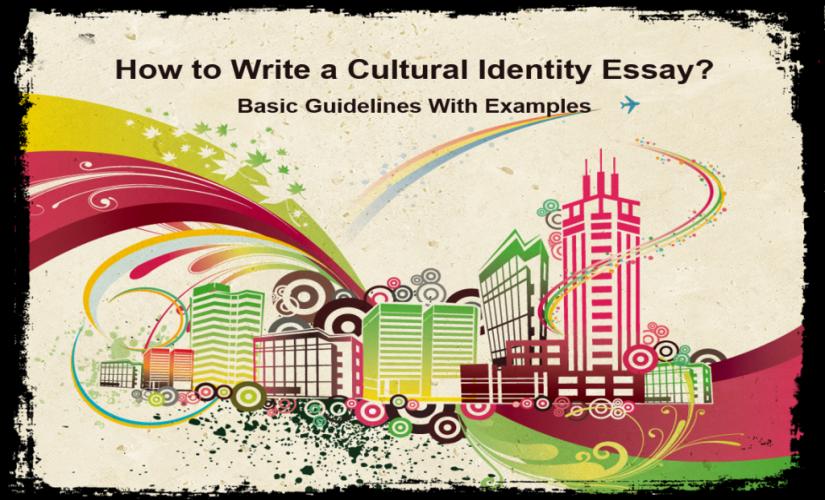
| Section | Content |
|---|---|
| Title | A clear, concise, and engaging title that reflects your essay’s focus. |
| Introduction | Introduce a concept of your cultural identity. |
| Write a short overview of what your essay will cover. | |
| State a thesis that outlines your main points or focus of an essay. | |
| Background | Provide context about your ancestral background. |
| Discuss some origins, history, and key elements of your culture (ethnicity, language, traditions, etc.). | |
| Personal Experience | Share personal examples and experiences related to your ethnic roots. |
| Explain how these experiences have shaped your beliefs, values, and identity. | |
| Cultural Influences | Discuss various social influences that have impacted your life. |
| Include family, community, education, and societal factors. | |
| Analysis and Reflection | Analyze how your ancestral orientation has influenced your worldview and interactions with others. |
| Reflect on some challenges and benefits of writing about your ethnic heritage. | |
| Cross-Cultural Comparisons (Optional) | Compare your culture with other cultures. |
| Highlight similarities and differences. | |
| Conclusion | Summarize your main points discussed in an essay. |
| Restate your thesis in a particular context of a text presented. | |
| Reflect on some challenges and benefits of your ethnic heritage. | |
| References (Optional) | List any sources cited in an essay and follow an appropriate citation style, like MLA, APA, Chicago/Turabian, Harvard, etc. |
Note: Some sections of a cultural identity essay can be added, deleted, or combined with each other. In writing, people explain their cultural identity by describing a unique mix of traditions, values, language, and personal experiences that have shaped their beliefs and sense of self.
Generally, a cultural identity essay is similar to a standard academic paper regarding its structure and outline. However, a central point of difference is a specific topic to write about. In this case, a cultural identity essay is a reflective exploration of how people’s ethnicities, family traditions, languages, and personal experiences have shaped their beliefs, values, and sense of self (Spelic, 2019). While standard academic papers, such as argumentative, persuasive, and informative essays, require learners to use third-person language, such a composition requires them to use first-person language. As such, authors should use the word “I” throughout to show a target audience that they are writing from their perspective. Indeed, this aspect is a primary objective of such an essay – to give a writer’s perspective concerning his or her culture (Davies et al., 2019). Besides, another point of difference between such an essay and other papers is that the former does not require writers to utilize external sources but to write from a personal viewpoint.
Examples of Cultural Identity Prompts
Cultural Orientation and Socialization in a Learning Environment
Here, this prompt may require students to discuss an actual significance of culture in education, focusing on ethnic heritage and socialization. As such, this topic requires writers to reflect on how culture influences behavior in a learning environment.
The Impact of Culture Change on Family
Here, a writing assignment may require students to explore and discuss how culture impacts a family unit. Moreover, a central theme is a family, and a student’s mission would be to explain how culture in all its dynamics affects families in diverse settings.
The Role of Language in Building an Ethnic Identity
Here, instructions may require students to explore and explain a particular significance of language in ethnic heritage. Hence, writers should focus on explaining a specific place of culture in a sociology discipline, focusing on a direct connection between language and cultural orientation.
The Significance of Culture in a Globalized Economy
Here, such a prompt may require students to explore and discuss how culture affects individuals and businesses in today’s connected world. Besides, a student’s task would be to explain how culture, in all its dynamics, such as language, is essential in business for individuals and enterprises.
How Culture Influences Relations in the Workplace
Here, an essay prompt may require students to explore and explain how culture, in all its dynamics, affects or influences social relations at the workplace. In turn, a particular task of writers, for example, would be to focus on how human resource (HR) departments can use culture to enrich workplace relations.
The Place of Culture in Individuals’ Self-Concept
Here, an analysis of a theme may require students to reflect on how their ethnic orientation has affected their self-concept. Moreover, a student’s task would be to discuss how culture and its dynamics enable individuals to build a strong or weak understanding of themselves.
The Importance of Cultural Orientation in a Multicultural Environment
Here, assignment writing instructions may require students to explore and discuss how their ethnic orientation enables them to operate in a culturally diverse environment, such as a school or workplace. In this case, a student’s task would be to explain how identity characteristics, such as language and religion, facilitate or hamper social competency in a multicultural setting.
How Global Conflicts Disturb Ethnic Identity for Refugees
Here, this prompt example may require students to explore and explain how conflicts in today’s world, such as civil unrest, affect a unique identity heritage of those who flee to foreign countries. As such, a student’s task would be to explain how one’s culture is affected in a new environment with totally different social dynamics.
The Challenges of Acculturation
Here, this kind of prompt may require students to explore and explain possible challenges that individuals face in identifying with a dominant culture. In particular, a student’s task would be to explain a specific significance of a dominant culture and what those from other cultures that try to identify with it must confront.
Host Country Culture and Multinational Enterprises
Here, this essay prompt sample may require students to explore and explain how a host country’s culture affects expatriates working for multinational corporations. Besides, a student’s task would be to show how one’s culture defines their behaviors and how that can be affected in a new environment with new social characteristics.
Compare and Contrast Native Culture and Dominant Culture in the United States
Here, such instructions require students to explain specific areas of similarity and difference between a Native culture and a dominant culture. In turn, a student’s task would be to define both a Native culture and a dominant culture and help a target audience to understand whether they mean the same thing. Hence, whether they do or do not, students should elaborate.
The Objective of Acculturation
Here, this prompt example requires students to explore and explain why people prefer to identify with a dominant culture. Moreover, a student’s task would be to note some advantages of a dominant culture over others and possible opportunities that one may access to identify with this dominant culture.
The Challenges That the LGBTQ Community Faces in the Modern World
Here, essay prompt instructions require students to explore and discuss potential challenges that lesbians, gays, bisexuals, and transgender people face in their normal day-to-day activities. In this case, a student’s task would be to explain an uniqueness of a LGBTQ community and how stereotyping makes their lives miserable in an environment where people are intolerant of different personalities and viewpoints.
Dangers of Cultural Intolerance in the Health Care System
Here, assignment instructions may require students to explore and discuss how nurses who are intolerant of social differences may jeopardize patients’ lives.
Advantages and Disadvantages of Acculturation
Here, such a prompt requires students to discuss some pros and cons of identifying with a dominant culture.
How to Know
Key defining features of a cultural identity essay give students a particular indication that they need to write this kind of paper. For example, cultural identity is important because it shapes people’s traditions, customs, languages, family practices, historical backgrounds, values, beliefs, personal experiences, and sense of belonging, fostering self-awareness and promoting a deeper understanding and appreciation of lifestyle diversity (Heersmink, 2021). Hence, when students read instructions regarding their essay topics they need to write about, they should identify one or several defining elements. In turn, these elements include language, nationality, religion, ethnicity, and gender.
Steps on How to Write a Cultural Identity Essay
To write a cultural identity essay, people reflect on and describe some significant aspects of their ethnic backgrounds, such as traditions, language, and experiences, and analyze how they have influenced their worldview. In turn, common steps for writing a good cultural identity essay are:
- Understand an Assignment: Read and comprehend an essay’s prompt to ensure you meet all requirements.
- Choose a Focus: Select specific aspects of your ethnic heritage to highlight in your essay.
- Conduct Research: Gather information about your ancestral background and its historical context.
- Brainstorm and Outline: Reflect on your cultural experiences and organize your thoughts into an outline.
- Write a Strong Introduction: Write an engaging opening with a hook, background information, and a thesis statement.
- Develop Body Paragraphs: Discuss each aspect of your ethnic heritage with personal examples and reflections.
- Incorporate Cultural Influences: Explore an actual role of family, community, and society in shaping your social orientation.
- Address Challenges and Pride: Highlight any challenges faced and express pride in your actual roots.
- Write a Logical Conclusion: Summarize key points, restate a central thesis, and offer final thoughts on identity heritage.
- Revise and Edit: Review for coherence, clarity, and errors, and make revisions based on feedback.
As stated previously, a primary point of similarity between a cultural identity essay and standard papers is its writing structure and outline. In this case, to start a cultural identity essay, people begin with an engaging hook, provide background context on their ethnic heritage, and present a clear thesis statement that outlines main aspects of their roots they will explore further (Spelic, 2019). Basically, this structure and outline comprise three main sections: introduction, body, and conclusion. Like in all other papers, writing such a composition requires students to address specific issues, which are, in essence, a defining characteristics of an essay’s structure and outline. In turn, some examples of sentence starters for beginning a cultural identity essay include:
- Growing up in a household where [specific cultural practices] were a daily routine, my ethnic heritage was shaped by specific traditions and values of my [ethnicity/nationality] heritage.
- A rich picture of my lifestyle is woven from diverse threads of my family’s history, which includes [briefly mention key ethnic elements].
- From a young age, I was impressed by unique customs of my [specific social group], where celebrations and rituals played a crucial role in shaping my sense of self.
- My journey to understanding my cultural roots began with shared stories that my grandparents told me about their experiences in [country/region], which instilled in me a deep appreciation for our heritage.
- A direct connection between [ethnicity] and [ethnicity] cultures in my upbringing provided me with a unique perspective on life and allowed me to embrace my complex heritage.
- Living in a multicultural community, I was constantly surrounded by different traditions and practices, which enriched my understanding of my own ethnic identity.
- Reflecting on my childhood, I realized that cultural festivals and family gatherings we celebrated were essential in fostering a strong connection to my [specific culture] roots.
- A particular influence of my ancestral background on my personal values and beliefs is profound, as it has shaped my worldview and interactions with others in significant ways.
- As a child of immigrants, my life was shaped by blending my parents’ homeland traditions with new cultural norms of our adopted country.
- Understanding and embracing my ethnic roots has been a continuous journey, marked by moments of both pride and challenge, as I strive to honor my heritage while finding my place in a current world.
Introduction and Its Defining Characteristics
An introduction is the first paragraph of a cultural identity essay. Here, students introduce themselves to a target audience, giving a brief background of their ethnic heritage. Moreover, rules of academic writing dictate that this part should not exceed 10 percent of a whole word count of an entire paper (Greetham, 2023). In this case, writers should be brief and concise. Then, the most prominent component of this section is a thesis, a statement that appears at the end of an introduction paragraph and whose objective is to indicate a writer’s mission. In summary, the introduction part’s defining features are a writer’s background and thesis statement. In turn, the former gives a hint about a writer, and the latter provides a target audience with insight into a author’s objective in writing a cultural identity essay.
Body Paragraphs
A body element of a cultural identity essay is the most significant section of a paper and takes the largest part. Generally, writers use several paragraphs to advance different arguments on their ethnic heritage to explain specific concepts (Karjalainen, 2020). In writing a cultural identity essay, authors can use different paragraphs to explain important aspects of their ethnic heritage. Nonetheless, what determines the number of paragraphs and the content of each is a paper topic (Greetham, 2023). Besides, the most prominent defining features of a essay’s body are paragraphs, with each advancing a unique concept about a writer’s ethnic heritage. In turn, paragraphs are where writers provide real-life experiences and other personal anecdotes or examples that help a target audience to develop a deeper understanding of authors from a cultural perspective.
A conclusion part is the last section of a cultural identity essay. In particular, writers restate a thesis statement and summarize main points from body paragraphs (Greetham, 2023). Moreover, authors provide concluding remarks about a topic, which is mostly an objective personal opinion. In summary, the conclusion part’s defining features are a restatement of a thesis, a summary of main points, and writer’s final thoughts about a topic.
Outline Template
I. Introduction
A. Hook statement/sentence. B. Background information. C. A thesis statement that covers main ideas from 1 to X in one sentence.
II. Body Paragraphs
A. Idea 1 B. Idea 2 … X. Idea X
III. Conclusion
A. Restating a thesis statement. B. Summary of the main points from A to X. C. Final thoughts.
An Example of a Cultural Identity Essay
Topic: Identifying as a Naturalist
Introduction Sample
The period of birth marks the beginning of one’s identity, with culture playing a significant role. However, from the stage of adolescence going forward, individuals begin to recognize and understand their cultural makeup. In my case, I have come to discover my love for nature, an aspect that I believe has made me a naturalist both in belief and action.
Examples of Body Paragraphs
Idea 1: Parents
Parents play a critical role in shaping a cultural and personal identity of their children. In my case, it is my mother who has instilled in me a love for nature. Although I may not say exactly when this love started, I can only reason that since it was ingrained in me since childhood, it has developed gradually.
Idea 2: Naturalism
Today, naturalism defines my interactions with people and the environment. In short, I can say it shapes my worldview. As a lover of nature herself, my mother had this habit of taking me outdoors when I was a toddler. I have seen family photographs of my mother walking through parks and forests holding my hand. What is noticeable in these pictures besides my mother and me is the tree cover that gives the setting such a lovely sight. Moreover, I can now understand why I seem more conversant with the names and species of flowers, trees, and birds than my siblings- my mother was the influence. In turn, my siblings and friends make a joke that I have developed a strong love for nature to the point of identifying myself with the environment. Hence, the basis for this argument is my love for the green color, where even my clothes and toys are mostly green.
Conclusion Sample
Naturally, human beings behave in line with their cultural background and orientation. Basically, this behavior is what determines or reflects their ethnic identity. In turn, my intense love for nature underscores my naturalist identity. While I may not tell the stage in life when I assumed this identity, I know my mother has played a significant role in shaping it, and this is since childhood.
What to Include
| Element | Content |
|---|---|
| Ethnicity and Nationality | Explore your ancestral background and national heritage, including traditions, customs, and cultural history. |
| Family Traditions | Discuss some unique rituals, celebrations, and customs practiced by your family, as well as their significance. |
| Language | Describe particular languages you speak, dialects, regional languages, and how being multilingual affects your identity. |
| Religion and Spirituality | Share your religious beliefs, spiritual practices, and faiths and how they influence your daily life and ethnic heritage. |
| Cuisine | Highlight traditional dishes, cooking practices, and family recipes that hold a real social significance. |
| Music and Arts | Write about traditional music, dance, cultural festivals, and artistic expressions that are part of your heritage. |
| Clothing and Fashion | Describe your traditional dress code, its significance, and unique aspects, as well as how such a fashion influences your ethnic roots. |
| Social Norms and Values | Explore cultural etiquette, community values, gender roles, and expectations within your ethnic context. |
| Education | Reflect on how social influences shape educational choices, learning experiences, and some roles of bilingual or multicultural education. |
| Historical Background | Provide a particular context on important historical events, ethnic heritage sites, and figures that influenced your culture. |
| Personal Experiences | Share personal examples, interactions with others from the same or different cultures, and moments of cultural pride or challenge. |
| Community and Social Life | Discuss a specific role of your community in shaping your identity, including social gatherings, communal activities, and support systems. |
| Migration and Acculturation | Describe experiences of immigration, adaptation to new cultures, and balancing multiple ethnic identities. |
Common Mistakes
- Lack of Focus: Failing to narrow down an essay to specific aspects of cultural identity, leading to an unclear narrative.
- Vague Thesis Statement: Providing a weak or unclear thesis statement, which makes it difficult for readers to understand an essay’s main argument.
- Insufficient Personal Reflection: Neglecting to include personal examples and reflections, which are crucial for illustrating an actual impact of ethnic heritage.
- Overgeneralization: Making broad and unsupported statements about specific groups rather than focusing on personal and specific experiences.
- Ignoring Historical Context: Failing to provide historical or ethnic background that can help readers to understand a real significance of certain traditions or practices.
- Poor Organization: Structuring an essay poorly, resulting in an illogical and difficult-to-follow narrative.
- Lack of Depth: Addressing ethnic heritage without explaining how it shapes beliefs, values, and behaviors.
- Cultural Stereotyping: Relying on stereotypes or clichés rather than presenting a personal perspective on ethnic roots.
- Inadequate Conclusion: Providing a weak conclusion that does not effectively summarize main points or reflect on a real significance of a particular ethnic heritage.
- Ignoring Feedback and Revision: Failing to seek feedback from others or revise a cultural identity essay, which can leave writing errors and unclear sections unaddressed.
Like any standard paper, writing a cultural identity essay allows students to build essential skills, such as critical thinking, reflective, and analytical skills. In this case, a real essence of such a paper is to provide a writer’s cultural identity, background, or orientation. As such, in order to learn how to write a good cultural identity essay, students should master following tips:
- Decide where to focus. Culture is a broad topic, and deciding what to focus on is essential in producing such an essay. Basically, one may have several ethnic identities, and addressing all may lead to inconclusive explanations.
- Reflect and brainstorm. Given a close link between one’s cultural orientation and personal experiences, learners need to reflect on experiences that would provide a target audience with an accurate picture of their ethnic heritage.
- Adopt a “Show, not tell” approach by providing vivid details about one’s experiences. Using personal anecdotes may be effective in accomplishing this objective.
- Use transitions , such as “therefore,” “thus,” ” additionally,” and “furthermore,” to enhance a natural and logical flow throughout an essay.
- Stay personal by using first-person language to describe one’s background and experiences.
- Proofread a final document to eliminate spelling and grammatical mistakes and other notable errors, such as an inconsistent life storyline.
Davies, S. R., Halpern, M., Horst, M., Kirby, D., & Lewenstein, B. (2019). Science stories as culture: Experience, identity, narrative and emotion in public communication of science. Journal of Science Communication , 18 (05), 1–17. https://doi.org/10.22323/2.18050201
Greetham, B. (2023). How to write better essays . Bloomsbury Academic.
Heersmink, R. (2021). Materialised identities: Cultural identity, collective memory, and artifacts. Review of Philosophy and Psychology , 14 (1), 249–265. https://doi.org/10.1007/s13164-021-00570-5
Karjalainen, H. (2020). Cultural identity and its impact on today’s multicultural organizations. International Journal of Cross Cultural Management , 20 (2), 249–262. https://doi.org/10.1177/1470595820944207
Spelic, S. (2019). Care at the core conversational essays on identity, education and power . Tredition.
Wallace, K. (2021). Network self: Relation, process, and personal identity . Routlage.
To Learn More, Read Relevant Articles
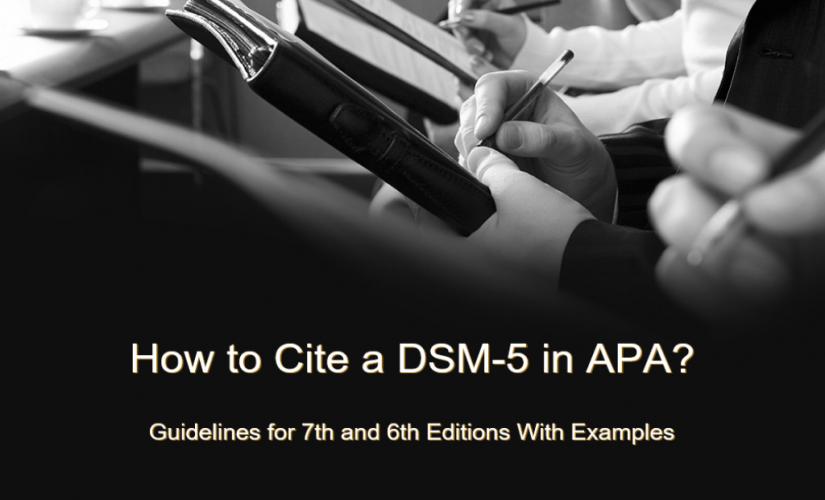
How to Cite a DSM-5 in APA 7 and 6: Guidelines With Examples
- Icon Calendar 7 October 2020
- Icon Page 2790 words
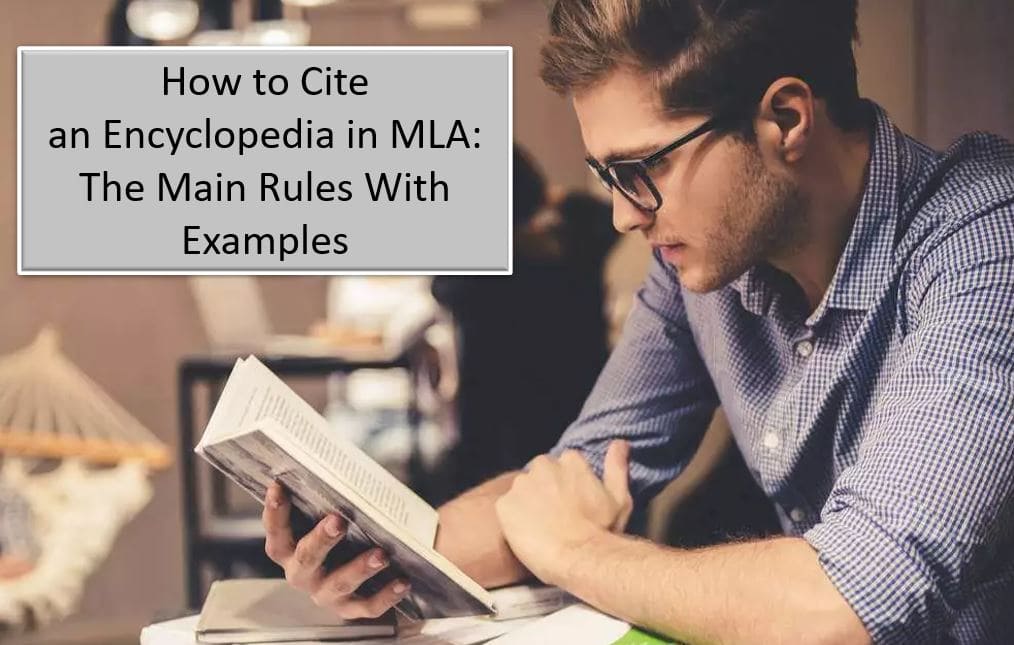
How to Cite an Encyclopedia in MLA 9: The Main Rules With Examples
- Icon Calendar 5 October 2020
- Icon Page 1361 words

How to Write an Essay about Your Culture

Do you need to write an essay about your culture but don’t know where to start? You’ve come to the right place! I’m Constance, and I’ll show you how to write an essay about your culture. I’ll guide you step by step, and we’ll write a sample essay together. Let’s dive in.
Writing an essay about your culture includes 5 steps:
Step 1. Plan how many words you want in each paragraph.
When you know the exact number of words you need for an essay, planning the word count for each paragraph will be much easier.
For example, a 300-word essay typically consists of five paragraphs and three key elements:
- The introductory paragraph.
- Three body paragraphs.
- The conclusion, or the concluding paragraph.
Here’s a simple way to distribute 300 words across the five paragraphs in your essay:
You’ll get 300 when you add up these numbers.
Step 2. Decide on what your main and supporting points will be.
First, you must take a stand, meaning you must decide on your main point. What do you really want to say about your culture? Whatever you want to say, that becomes your thesis.
For example, “My culture is very rich.” That is enough to get started. You’ll get a better idea of how to expand or tweak your thesis after the next step.
Next, divide your topic using the Power of Three to prove the point that your culture is rich using three supporting ideas.
The Power of Three effectively divides an essay’s main idea into its supporting points. It means your main idea is true because of the three reasons you will provide in the body. So, it is a three-part structure that helps produce your body paragraphs .
Let’s try it for an essay about Filipino culture!
For example, here are three supporting ideas explaining the richness of Filipino culture:
- The Philippines has incredible food .
- Traditional Filipino clothing reflects the country’s heritage.
- Family values in the Philippines are essential.
Great! Now we have everything we need to write an essay about Filipino culture. We’re all set for the next step!
Step 3. Write your introductory paragraph.
Here are the key components of an introductory paragraph you need to remember in writing your essay:
Our first sentence is the introduction, which should pull our reader into the world we want to portray in our essay.
And the rest of the introductory paragraph is our thesis statement. It includes our main idea and three supporting points.
Example of an introductory paragraph about culture
“Having been colonized for centuries, the Philippines boasts a vast heritage. It has a rich culture characterized by food, clothing, and family values. Filipino culture has delicious food inherited from diverse parts of the world and periods of conquest. Traditional Filipino clothing reflects the country’s history, as well. And Filipinos prize their family values probably above all else.”
Look at how the introductory paragraph goes from a general statement to specific ideas that support our main idea.
Our introductory sentence is a general statement that serves as the opening in our essay. It briefly sets the essay’s context. Next comes the thesis statement — our main idea. Finally, we have three supporting ideas for our thesis.
Step 4. Write your essay’s body paragraphs.
Again, a 300-word essay typically has three body paragraphs containing your three supporting ideas. Here’s how to structure a body paragraph:
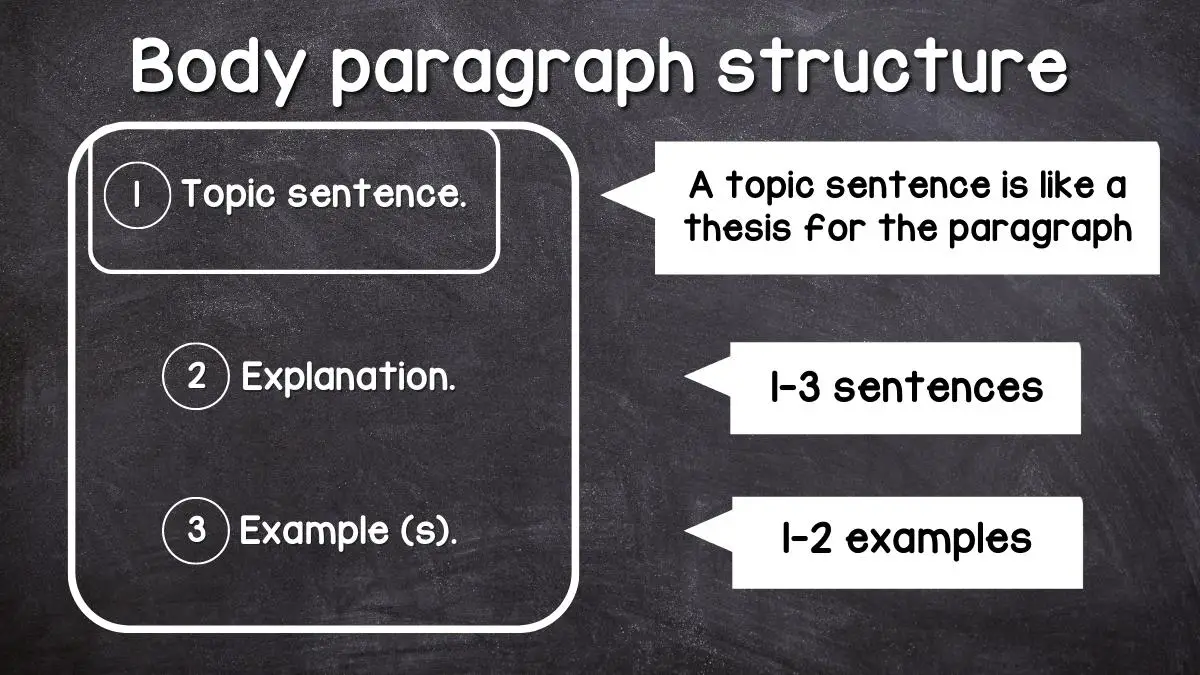
Looking back at our word count plan, we know that our body paragraphs should have roughly 70 words each. Remember your word plan as you write.
Body Paragraph 1
“The Philippines boasts a diverse food culture. It reflects indigenous flavors and foreign influences, such as American, Spanish, Indian, and Chinese. Whether it’s a typical or special day, Filipinos love eating these various dishes with rice, a staple. For example, rice goes well with curry, noodles, and adobo. It is also common to see various foods like pizza, pancit, lumpia, paella, (Filipino-style) sweet spaghetti, cakes, and ice cream at parties.”
As you can see, the first sentence in this body paragraph is a topic sentence . It gives context to the paragraph and briefly summarizes it.
The second sentence explains why the Philippine food culture is considered diverse.
The remaining sentences illustrate your main point (topic sentence) by providing examples, starting with rice in sentence 3.
Body Paragraph 2
“Traditional Filipino clothing reflects Philippine cultural heritage. Although Filipinos now conform to current fashion trends in their everyday lives, the traditional clothing style is often used during celebrations. The traditional fashion sense exhibits influences from indigenous tribes, Chinese immigration waves, the Spaniards, and Americans, portraying the chronology of Philippine historical events. For example, the Philippines’ national costume, the baro’t saya, is an elegant blend of Spanish and Filipino clothing styles. Even some modernized forms of clothing also display other global influences.”
Just like Body Paragraph 1, this paragraph follows the same structure outlined in the diagram. It proceeds from a general statement to more specific points :
- The topic sentence.
- An explanation.
Body Paragraph 3
“Family values are vital in the Philippines. The daily lives of most Filipinos revolve around close and extended family, making them known for their family-oriented lifestyle even when they’re overseas. It’s common for children to live with their parents after reaching legal age; some even stay after getting married or obtaining a job. Filipinos also cherish their extended families (aunts, uncles, grandparents, and cousins) and hanging out or celebrating significant events together.”
Once again, this paragraph follows the body paragraph structure. Now, we’re all set for the final step — the conclusion.
Step 5. Write the conclusion.
The easiest way to write a concluding paragraph for your essay on your culture is to restate your main idea and its supporting points using different words. You can even paraphrase your introduction — a time-proven method!
Let’s write the conclusion for our essay.
“Because of its history, the Philippines has a rich, diverse culture rooted in a vast heritage. Filipino cuisine is a blend of indigenous and foreign flavors. The nation’s history is reflected in its traditional clothing. And family values display a distinct Filipino trait.”
Note that this conclusion uses different words to restate the points we’ve already made, including those in the body paragraphs.
Hope this was helpful. Now go ahead and write an essay about your culture!
Tutor Phil is an e-learning professional who helps adult learners finish their degrees by teaching them academic writing skills.
You Might Like These Next...
How to Write a 300 Word Essay - Simple Tutorial
https://youtu.be/qXST2gJbkhw If you need to write a 300-word essay, you’ve come to the right place. I’m Tutor Phil, and in this tutorial I’ll guide you through the process step by...
Essay Writing for Beginners: 6-Step Guide with Examples
https://youtu.be/w6yanrc1a_g If you need to write an essay, whether for a college course or to pass a writing test, this guide will take you through the process step-by-step. Even if you have...

Culture and Its Effects on People’s Identity Essay
- To find inspiration for your paper and overcome writer’s block
- As a source of information (ensure proper referencing)
- As a template for you assignment
Introduction
Counterargument, works cited.
Culture is often viewed as a factor affecting people’s identity, which is partially true. The key problem in locating the influence of culture on identity is that the latter incorporates both the inherent and the acquired characteristics. Herein the complexity of the chemistry between the two notions lies, as culture may only alter the character traits that are developed over the course of people’s interactions with the world and cannot possibly change the inherent ones, such as ethnicity, gender, or sexuality.
Though culture clearly affects the views on homosexuality in a rather obvious way, as it either spawns a vehement resistance to the ideas of tolerance or, on the contrary, encourages the celebration of differences among individuals, it cannot possibly change the elements of identity that are implanted into it intrinsically, such as sexual identity, which Ha Jin’s The Bridegroom is a graphic example of.
One of the most obvious arguments concerning the impossibility of altering one’s identity with the help of cultural influence, the description of Bowen’s relationships with his wife deserves to be mentioned. Bowen’s loving wife and her attitude towards his sexual preferences stand in striking contrast to the violent rejection of the Chinese society, which clearly makes Baowen remorseful about his identity, yet he cannot do anything about it.
The social pressure, which Baowen experiences after the reveal of his identity and the subsequent victimization by the Chinese society, can also be considered a sociocultural factor that fails to change Baowen’s identity in the end. Speaking of which, the utter intolerance of homosexual people, which the society depicted in the novel displays, is horrifying in its naïve self-righteousness.
The blind fear of people that differ from the so-called “norm” twists people’s idea of social acceptance and justifies discrimination against people of an alternative sexual orientation as an attempt to protect the society from a certain malady: “It’s a social disease, like gambling, or prostitution, or syphilis” (Jin 518).
However, even the grievous experience of being shunned to the point where he became ostracized did not make Baowen alter his sexual identity. Even the imminent punishment that awaits him as the society discovers his identity does not make Baowen reconsider his preferences, which means that he has no possible power over it: “I – I liked a man in the club, a lot. If he’d asked me, I might’ve agreed” (Jin 519).
It is quite remarkable that Jin also provides a rather detailed and embarrassingly obvious explanation of the reasons for the discrimination to occur: “Homosexuality originated in Western capitalism and bourgeois lifestyle. According to our law, it’s dealt with as a kind of hooliganism” (Jin 518). The fact that sexual profiling occurred on the basis of political and cultural enmity between China and the Western world adds to the line of arguments concerning the inconsistency between culture and identity.
While the latter has a very strong foundation to be based on and is mainly dependent on the specifics of one’s personality, as well as the inherited traits, the former is quite transient and is affected greatly by the economic and political relationships between the neighboring states. The intolerance of homosexual people in China on the specified time slot was, therefore, influenced heavily by the tense relationships between China and West, where homosexuality was being acknowledged as an inherent characteristic.
Finally, the fact that culture cannot possibly affect one’s identity can be proven by the fact that even Baowen’s wish to change as he is being tortured does not have the slightest effect on his sexuality: “Let me say this again: there is no cure for your son-in-law, old Cheng. It’s not a disease; it’s just a sexual preference; it may be congenital, like being left-handed. Got it?” (Jin 527).
The given element of the narration is, in fact, heart-wrenching to the point where it becomes disturbing. Brown spells out his desire to change his identity; therefore, he wishes to accept the cultural standards. Nevertheless, the desire to change, which overpowers him as he feels increasingly guilty, does not change anything.
As he is given the so-called “electric bath,” he assumes that he is being treated the proper way and, though being in great pain, demands further “treatment” so that he could be accepted in the society once again: “’ No, give me more!’ Baowen said resolutely without opening his eyes, his face twisted” (Jin 524). However, even this plea for change does not have any palpable effect.
It should be noted, though, that the effects of culture on identity are admittedly large. Indeed, claiming that culture has nothing to do with identity whatsoever would be wrong – the two, in fact, are closely related to each other on a range of levels. For instance, the process of assimilation, which may occur once a person is introduced to an entirely different environment, is a graphic example of the way in which culture and identity are intermingled.
Specifically, the way in which culture shapes one’s attitude towards specific phenomena and the perception of specific standards, ethical and moral ones notwithstanding, is a clear-cut manifestation of culture-shaping identity. For example, a certain attitude towards homosexuality within a society is an obvious effect of culture on people’s identity.
In Jin’s novel, for instance, discrimination of gay people is not the result of people’s intrinsic hatred towards homosexuals, but the result of the culturally accepted morals altering people’s standpoint. The latter, in its turn, makes a major part of identity; therefore, the two notions may be viewed as related.
As convincing as the argument concerning the links between culture and identity may be, one still must admit that the acquired features, which an impressive part of one’s identity consists of, coexist with the inherent ones, the latter including also sexual identity. In other words, identity is a very complex phenomenon that incorporates both acquired and inherent features, sexual orientation belonging to the ones that cannot possibly be altered under the pressure of any circumstances.
The effects of culture on people’s identity may vary based on whether these are inherent or acquired elements of one’s identity that are under the impact of the environment. While the latter, such as the attitudes towards sexuality and societal norms and morals, may be shaped, the sexual orientation itself cannot possibly be altered, as it is not defined by the standards within the society in question.
Neither oppression, nor persuasion may possibly alter one’s sexual identity, and Bowen’s case is a graphic example of that. Cultural tolerance is the only possible way of dealing with differences between the identities of individuals, whereas violence and aggression towards something or someone that seems different is never the answer.
Jin, Ha. “The Bridegroom.” The Bridegroom . New York, NY: Random House, 2000. 515–529. Print.
- Mr. Chiu: "Saboteur" by Ha Jin
- First-Person Narrative in Bowen's ”The Demon Lover,” Updike's ”A&P,” Fitzgerald's ”The Great Gatsby”
- "The Smiling Proud Wanderer" a Story by Jin Yong
- Race and Culture which Defines Us
- The Story of Viet Nam: From Prehistory to the Present written by Shelton Woods
- Indian Identity in UK
- Culture and Identity: "The House on Mango Street" by Sandra Cisneros
- Jewish Identity in America
- Chicago (A-D)
- Chicago (N-B)
IvyPanda. (2020, May 1). Culture and Its Effects on People’s Identity. https://ivypanda.com/essays/culture-and-its-effects-on-peoples-identity/
"Culture and Its Effects on People’s Identity." IvyPanda , 1 May 2020, ivypanda.com/essays/culture-and-its-effects-on-peoples-identity/.
IvyPanda . (2020) 'Culture and Its Effects on People’s Identity'. 1 May.
IvyPanda . 2020. "Culture and Its Effects on People’s Identity." May 1, 2020. https://ivypanda.com/essays/culture-and-its-effects-on-peoples-identity/.
1. IvyPanda . "Culture and Its Effects on People’s Identity." May 1, 2020. https://ivypanda.com/essays/culture-and-its-effects-on-peoples-identity/.
Bibliography
IvyPanda . "Culture and Its Effects on People’s Identity." May 1, 2020. https://ivypanda.com/essays/culture-and-its-effects-on-peoples-identity/.

This page has been archived and is no longer being updated regularly.
Culture and the Self
July 26, 2016
Social scientists have long understood that people in different parts of the world see themselves in different ways, but research has often been driven by a rather black-and-white — and some would say stereotypical — view of what the differences are.
In an article just published in Journal of Experimental Psychology: General , Vignoles and colleagues (2016) (PDF, 209KB) introduce a new perspective on cultural differences in self-construal. Funded by the Economic and Social Research Council (UK), and conducted by members of the Culture and Identity Research Network among more than 10,000 members of diverse cultural groups spanning all inhabited continents, their research explodes the common myth of a "West-versus-the-Rest" divide in self-perceptions.
For several decades, psychological scientists have commonly assumed that Western cultures foster seeing oneself as independent from others, whereas the rest of the world's cultures foster seeing oneself as interdependent with others. Critics have argued that this view of cultural diversity is too simplistic, but it has remained a dominant assumption in the field — and researchers often explain unsupportive findings away as methodological failures rather than question it.
The new research paints a much richer picture of diversity in cultural models of selfhood. It shows that Western cultures tend to emphasize certain ways of being independent (e.g., being different from others, self-directed, and self-expressive), but not others (e.g., being self-interested, self-reliant, and consistent across contexts).
Viewed in global context, Western cultures are not "exceptional" but they form part of the broad kaleidoscope of global variation. Nor is cultural individualism linked straightforwardly to independent self-perceptions, as has been commonly presumed. Different ways of seeing oneself as both independent and interdependent were emphasized in different parts of the world, and this was partly explained by socioeconomic development and religious heritage of the cultural groups studied.
The findings will be important to practitioners and researchers interested in cultural diversity. They open up new research possibilities that will help researchers better understand how psychological processes vary across the world.
A richer understanding of cultural variation, based firmly on empirical research rather than stereotypes, could help practitioners intervene more effectively with members of diverse cultural communities.
- Vignoles, V. L., Owe, E., Becker, M., Smith, P. B., Easterbrook, M. J., Brown, R.,…Bond, M. H. (2016). Beyond the 'east–west' dichotomy: Global variation in cultural models of selfhood. Journal of Experimental Psychology: General, 145 (8), 966–1000. http://dx.doi.org/10.1037/xge0000175
Note: This article is in the Basic / Experimental Psychology topic area. View more articles in the Basic / Experimental Psychology topic area.
APA Journals Article Spotlight ®
APA Journals Article Spotlight is a free summary of recently published articles in an APA Journal .
Browse Article Spotlight topics
- Basic/Experimental Psychology
- Clinical Psychology
- Core of Psychology
- Developmental Psychology
- Educational Psychology, School Psychology, and Training
- Forensic Psychology
- Health Psychology and Medicine
- Industrial/Organizational Psychology and Management
- Neuroscience and Cognition
- Social Psychology and Social Processes
Contact APA Publications
Essay On Our Culture Is Our Pride
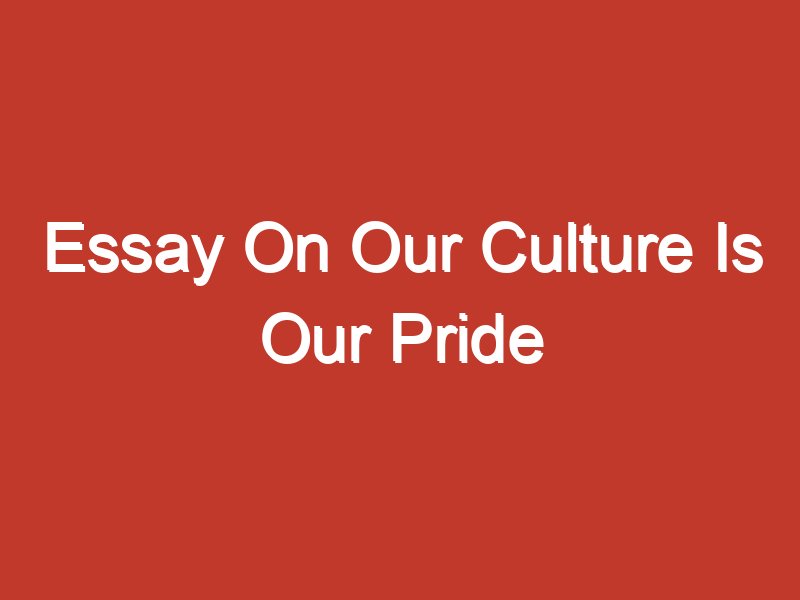
Table of Contents
Short Essay On Our Culture Is Our Pride
Culture is an integral part of a society’s identity, representing the beliefs, values, customs, and traditions passed down from generation to generation. Our culture is a source of pride, a reflection of who we are as a people and a symbol of our heritage and history. It is what makes us unique and sets us apart from other cultures and nations.
Culture can be seen in the food we eat, the music we listen to, the festivals we celebrate, and the traditions we follow. It is a representation of our shared experiences and memories, and a way for us to connect with our past and future generations. Our culture is a reflection of our history, reflecting the challenges and triumphs of our ancestors, and shaping the way we view the world today.
Culture is also a source of pride, as it allows us to express ourselves and to celebrate our heritage. Whether it’s through traditional dance, music, or festivals, our culture gives us the opportunity to express our individuality and connect with others who share our cultural background.
In conclusion, our culture is our pride, a reflection of our heritage, history, and identity. It is a source of unity and a way for us to connect with others who share our cultural background. By celebrating our culture and preserving our traditions, we ensure that our heritage is passed down from generation to generation, and that our cultural identity remains strong and vibrant.
Long Essay On Our Culture Is Our Pride
Introduction.
Culture is an essential aspect of a society’s identity. It represents the beliefs, values, customs, and traditions that have been passed down from generation to generation. Culture is a reflection of our heritage and history, and it is what makes us unique and sets us apart from other cultures and nations.
Definition of Culture
Culture refers to the shared beliefs, values, customs, behaviors, and artifacts that characterize a group or society. It encompasses everything from language, religion, music, and food, to traditions, festivals, and even clothing styles. Culture is not static, but it evolves over time, reflecting the changing attitudes and experiences of a society.
Importance of Culture
Culture is important for several reasons. Firstly, it is a source of pride, allowing us to celebrate our heritage and to express our individuality. Secondly, culture provides us with a sense of identity and belonging, helping us to feel connected to our past and future generations. Finally, culture is a way for us to connect with others who share our cultural background, allowing us to form strong bonds and to feel a sense of community.
Preserving Our Cultural Heritage
Preserving our cultural heritage is crucial if we want to ensure that our culture remains strong and vibrant. This can be achieved through various methods, such as educating people about our cultural history and traditions, promoting cultural events and festivals, and preserving important cultural landmarks and sites.
The Role of Traditions and Festivals
Traditions and festivals play an important role in preserving our cultural heritage. They are a way for us to celebrate our heritage and to connect with others who share our cultural background. Whether it’s through traditional dance, music, or food, traditions and festivals give us the opportunity to express ourselves and to celebrate our cultural identity.
The Impact of Globalization
In today’s increasingly globalized world, it is important that we work to preserve our cultural heritage. Globalization has brought about many positive changes, but it has also led to the loss of cultural heritage in many countries. By promoting our cultural heritage and by working to preserve our traditions and festivals, we can ensure that our culture remains strong and vibrant, even in the face of globalization.
In conclusion, our culture is our pride, a reflection of our heritage, history, and identity. It is a source of unity and a way for us to connect with others who share our cultural background. By celebrating our culture and preserving our traditions, we ensure that our heritage is passed down from generation to generation, and that our cultural identity remains strong and vibrant. Our culture is a source of pride, allowing us to express ourselves and to celebrate our heritage, and it is our responsibility to preserve and promote it for future generations

Manisha Dubey Jha is a skilled educational content writer with 5 years of experience. Specializing in essays and paragraphs, she’s dedicated to crafting engaging and informative content that enriches learning experiences.
Related Posts
Essay on importance of yoga, essay on cow, climate change essay, essay on slaver, leave a comment cancel reply.
Your email address will not be published. Required fields are marked *
Save my name, email, and website in this browser for the next time I comment.
- Testimonials
- How it works
- Paper Writers Team
- Essay Writing Guide
- Free plagiarism checker
- Essay title generator
- Conclusion Generator
- Citation Generator
- Can ChatGPT Write Essays?

My Cultural Identity Essay: A Guide to Writing about Who You are
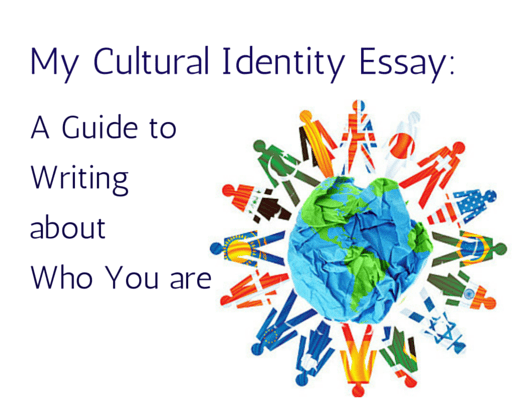
October 12, 2015
A cultural identity essay is a paper that you write exploring and explaining how your place of upbringing, ethnicity, religion, socio-economic status, and family dynamics among other factors created your identity as a person. Even facts such as what activities you took part in as a child can be part of your cultural identity. Your culture identity is ultimately the group of people that you feel that you identify with. The thought process behind this is known as cultural identity theory. To get a better idea of this, take a look at this single paragraph blurb of information that you might see in a culture identity essay. After reading, you can easily write my paper and feel comfortable getting grades as high as you can imagine.
Tired of searching something you need reading blogs? We care about your time and money! Use this 15% OFF Discount on any service you need and save your time now!
I was born in rural Missouri, but my family moved to St. Louis before I was a year old. My mother is 100 percent Irish and comes from a family that identifies very strongly with Irish culture. My father is Middle Eastern, but was adopted by an English family who moved to the United States when he was 5. We lived in a pretty big house in a subdivision. My parents had two more kids after me, they were both boys as well. My father wasn't religious, but my mom was a practicing Catholic. She went to mass every week. My brothers and I both had first communion and were confirmed, but stopped going to church as teenagers. We weren't really encouraged to play sports because our parents thought we should focus on our studies. They really emphasized math and science. I did well in these classes, but I didn't enjoy them. In high school, I became active in music and theater. Most of my friends were also into that as well. I earned a scholarship to study engineering on the East Coast, but I dropped out as a sophomore. I returned home to study music, needless to say my parents were disappointed. My brothers both pursued careers in technical fields. One is a mechanical engineer and the other is a software engineer. I am close with my family, but we do not have much in common. My circle of friends is fairly varied when it comes to race, ethnicity, religion, and economic background, but it consists almost entirely of people who are artists, musicians, writers, or people involved in those industries.
Keep in mind that your essay samples may look nothing like this. In our example, the writers choice of career, talents, and interests influenced his cultural identity more than his religious, ethnic background, or family values did. This may not be the case for you. Remember that when you are writing your paper there are no wrong answers. You just have to ask yourself insightful questions and keep the theory of cultural identity in mind as you write. Here are some questions to ask yourself:
- How did the foods I ate as a child influence my identity
- Did I look different from the kids I went to school with? How did that impact me?
- Did birth order influence who I am as an adult?
- Does my life today match the life I was raised in?

While being committed to a number of charitable causes, like volunteering at special events or giving free art lessons to children, Marie doesn’t forget her vocation – writing. She can write about almost anything but has focused on time management, motivation, academic and business writing.
Related posts

October 12 2015

Don`t have an account?
Password recovery instructions have been sent to your email
Back to Log in
Home — Essay Samples — Sociology — Cultural Identity — I Am Proud of My Cultural Identity
I Am Proud of My Cultural Identity
- Categories: Cultural Identity
About this sample

Words: 1139 |
Updated: 7 November, 2023
Words: 1139 | Page: 1 | 6 min read
- Chen, K., Shao, A., Jin, Y., & Ng, A. (2020). I Am Proud of My National Identity and I Am superior to You: The Role of Nationalism in Knowledge and Misinformation. Available at SSRN 3758287. (https://papers.ssrn.com/sol3/papers.cfm?abstract_id=3758287)
- Schwartz, S. J., Zamboanga, B. L., & Weisskirch, R. S. (2008). Broadening the study of the self: Integrating the study of personal identity and cultural identity. Social and Personality Psychology Compass, 2(2), 635-651. (https://compass.onlinelibrary.wiley.com/doi/abs/10.1111/j.1751-9004.2008.00077.x)
- Smolicz, J. (1981). Core values and cultural identity. Ethnic and racial studies, 4(1), 75-90. (https://www.tandfonline.com/doi/abs/10.1080/01419870.1981.9993325?journalCode=rers20)
- Hall, S., & Du Gay, P. (Eds.). (1996). Questions of cultural identity: SAGE Publications. Sage. (https://sk.sagepub.com/books/questions-of-cultural-identity)
- Lucy, S. (2007). Ethnic and cultural identities. In Archaeology of Identity (pp. 96-119). Routledge. (https://www.taylorfrancis.com/chapters/edit/10.4324/9780203087572-10/ethnic-cultural-identities-sam-lucy)
Video Version

Cite this Essay
Let us write you an essay from scratch
- 450+ experts on 30 subjects ready to help
- Custom essay delivered in as few as 3 hours
Get high-quality help

Dr. Heisenberg
Verified writer
- Expert in: Sociology

+ 120 experts online
By clicking “Check Writers’ Offers”, you agree to our terms of service and privacy policy . We’ll occasionally send you promo and account related email
No need to pay just yet!
Related Essays
4 pages / 1750 words
5 pages / 2405 words
2 pages / 823 words
8 pages / 3469 words
Remember! This is just a sample.
You can get your custom paper by one of our expert writers.
121 writers online

Still can’t find what you need?
Browse our vast selection of original essay samples, each expertly formatted and styled
Related Essays on Cultural Identity
"I Am Not Your Perfect Mexican Daughter" by Erika L. Sánchez is a literary masterpiece that intricately weaves together themes of cultural identity, family dynamics, and self-discovery. Within the pages of this novel, readers [...]
Frozen River reflects the complexities of cultural identities in America by showing us many examples of privilege, hard times, problems, racism, prejudice and alliance. It shows us different perspectives on multiple problems. In [...]
In our country today, we recognize the importance of preserving culture, which will be discussed in this essay. As we are a nation of diverse cultures, our society is a beautiful blend of African American, Asian [...]
The legends of Coyote go back hundreds of years, finding their beginnings in ancient Native American roots. In fact, the tales of Coyote have no real origin; many American Indian tribes have their own perspective of him. [...]
The idea of American dream is deeply stuck in the American people’s minds. American people strongly believe that if they had work hard enough, one day they will reach the American dream and become successful, even when people [...]
The Mexican-American War, one of many controversial wars in U.S history. In a debate over where the Mexican-American border was, and the ownership of none other than Texas. A war like this you never talk or hear much about it [...]
Related Topics
By clicking “Send”, you agree to our Terms of service and Privacy statement . We will occasionally send you account related emails.
Where do you want us to send this sample?
By clicking “Continue”, you agree to our terms of service and privacy policy.
Be careful. This essay is not unique
This essay was donated by a student and is likely to have been used and submitted before
Download this Sample
Free samples may contain mistakes and not unique parts
Sorry, we could not paraphrase this essay. Our professional writers can rewrite it and get you a unique paper.
Please check your inbox.
We can write you a custom essay that will follow your exact instructions and meet the deadlines. Let's fix your grades together!
Get Your Personalized Essay in 3 Hours or Less!
We use cookies to personalyze your web-site experience. By continuing we’ll assume you board with our cookie policy .
- Instructions Followed To The Letter
- Deadlines Met At Every Stage
- Unique And Plagiarism Free
Cornell Chronicle
- Architecture & Design
- Arts & Humanities
- Business, Economics & Entrepreneurship
- Computing & Information Sciences
- Energy, Environment & Sustainability
- Food & Agriculture
- Global Reach
- Health, Nutrition & Medicine
- Law, Government & Public Policy
- Life Sciences & Veterinary Medicine
- Physical Sciences & Engineering
- Social & Behavioral Sciences
- Coronavirus
- News & Events
- Public Engagement
- New York City
- Photos of the Week
- Big Red Sports
- Freedom of Expression
- Student Life
- University Statements
- Around Cornell
- All Stories
- In the News
- Expert Quotes
- Cornellians
Writing about identity, values can boost teens’ self-esteem
By james dean, cornell chronicle.
Providing teenagers opportunities to affirm positive aspects of their identities can help bolster their self-esteem over time and ease transitions to high school, new Cornell psychology research finds.
In a study involving nearly 400 ninth graders, students who completed short essays every few months about identities or values important to them reported stable or even improved self-esteem throughout the year, on average. Peers who didn’t complete the self-affirmation exercises saw average self-esteem drop significantly – a common phenomenon when starting high school.
The results suggest that in addition to values-based affirmations, which have been studied more extensively, identity-based affirmations could be beneficial at a time when teens are forging and becoming more aware of their identities, said Adam Hoffman , assistant professor in the Department of Psychology and College of Human Ecology.
“Self-esteem is derived from our social identities in some ways, and teens are starting to be shaped by their social identities in adolescence,” Hoffman said. “If we can encourage explicit socialization of their identity and frame it in a positive light, we may see better outcomes in mental health and overall well-being.”
Hoffman is a co-author of “ The Promise of an Identity-Based Self-Affirmation Intervention in Protecting Against Self-Esteem Declines at the High School Transition ,” published July 8 in Developmental Psychology, with Hannah Schacter , assistant professor of psychology at Wayne State University.
Though strong self-esteem is linked to better health and academic performance, it is known to stagnate or decline among adolescents starting high school. At that age, Hoffman said, students are developing a more complex and nuanced sense of self, while navigating new social relationships and being confronted with frequent opportunities to see how they measure up, such as through grades and athletics.
“Adolescents’ social cognition enables them to have more realistic self-perceptions and understandings of their abilities, and there are many ways to assess themselves in comparison with others,” Hoffman said. “We were interested in finding ways to help mitigate those normatively occurring dips that we see in self-esteem.”
Although prior research has focused how self-affirmations influence academic outcomes, Hoffman said, the new study is among the first to investigate their effects on psychological well-being, specifically self-esteem. Research to date also has overwhelmingly tested more traditional affirmations of values.
To test the benefits of an intervention affirming identities, the researchers recruited a diverse sample of 388 students from 38 schools in Michigan, averaging 14 years old. Participants completed up to five self-esteem assessments during ninth and tenth grade. Starting in the fall of 2020, as ninth graders, they were randomly assigned to one of three groups that completed a series of three writing exercises.
Responding to prompts every few months, participants in one group explained what they liked about an identity, selected from race/ethnicity, religion, sexual orientation, weight, immigrant status, language, disability, socioeconomic status or “other.” Another group focused on a value they considered important, such as creativity or sense of humor. And a control group wrote about that day’s morning routine.
The results showed self-esteem held steady for the first two groups, but declined over time for the control group, suggesting that the interventions had a “large effect” on average. That was particularly notable since the study took place during the COVID-19 pandemic, when students and adults were experiencing higher levels of stress, though the authors said additional research should be done in more normal conditions.
The scholars had expected to identity-based affirmations to bolster self-esteem the most. But they noted that teens are concurrently developing both identities and values that could protect them when facing increasing academic demands, difficulty with friends or family, or instances of discrimination.
“Perhaps it is not surprising that having repeated opportunities to positively reflect on anything of personal significance to the self – whether that be personal values or social identities – may offer a method for preserving a sense of self-worth,” the authors wrote.
Schools, counselors and parents could provide those opportunities with minimal disruption, the scholars said, to help teens feel better about themselves as they transition to high school.
“This is something that could be done in an English class in 10 minutes, a couple of times a year, and it’s super-easy and relevant for kids,” Hoffman said. “Any type of affirmation intervention, whether it’s based on their values or identity, is showing to help with self-esteem.”
The research was supported by grants from the Society for Research in Child Development and Wayne State University.
Media Contact
Kaitlyn serrao.
Get Cornell news delivered right to your inbox.
You might also like

Gallery Heading

- Table of Contents
Our Culture: Our Identity
- Importance of English Language
- Nepal Tourism
- Blood Donation Is Life Donation
- Muna Madan : Book Review
- Silk Route: The Past, Present and The Future
- Schools, Marks and Intelligence

YOU ARE READING
Copyright (c) by Safala Bista. No part of this book may be reproduced in any way, whether in electronic or printed form, without the permission of the author. If it is reproduced, credit must be given to the original owner of the Essays. Copying thi...
# english # essay # essayhelp # freewriting # literature # nepal # nonfiction # school # schoolassignment # schoolessay # wattys2018
- Post to Your Profile
- Share via Email
- Report Story
Our Culture Is Our Identity
Every person has their own unique identity and culture. Culture plays a huge role to shape our identity. A person's beliefs and morals are made up by the culture and they remain throughout the life of a human being. Culture is what makes a person who he/she is today and what he/she will be in the upcoming future, Identity of a person wouldn't exist if it was not for their own culture and values that they have carried along the years.
Culture, itself influences out behaviors, manners and morals. Such behaviors and morals of people determine their identity. People identify others on the basis of these aforementioned aspects only. They are identified as good people or bad people on the basis of their cultures. In this way, culture vastly influences our identity. Only a few people do not allow their culture to determine their identity and break out from such cultures for the better or the worse.
In Nepal, the phrase, 'Our Culture, Our Identity' is especially true. The lifestyle of Nepalese people is vastly influenced by culture, from dawn till dusk and from the birth till the death. Each and every moment of our life is directed by culture. Thankfully, most of our cultures are good. In our country, Nepal, there are variety of cultures of variety of castes, religions and ethnic groups. The cultures differ even among the people of same geographical regions as well as the people of the same state. Sometimes, they differ even among the people of the same castes and ethnic groups.
We recognize people on the basis of their cultures. We know about what caste and ethnic group they belong to, what state and region they come from and also about the country they are from. In the countries around the world, we Nepalese are known for our variety in the culture and our unity while celebrating them. Hence, 'Our Culture Is Our Identity'
Numbers, Facts and Trends Shaping Your World
Read our research on:
Full Topic List
Regions & Countries
- Publications
- Our Methods
- Short Reads
- Tools & Resources
Read Our Research On:
- Language and Traditions Are Considered Central to National Identity
Publics around the world divided on birthplace and religion as requirements for national belonging
Table of contents.
- 1. Views on the importance of language to national identity
- 2. Views on the importance of customs and traditions to national identity
- 3. Views on the importance of birthplace to national identity
- 4. Views on the importance of religion to national identity
- Acknowledgments
- Appendix A: National identity index
- Appendix B: Country-specific language
- Appendix C: Country-specific religion
- About Pew Research Center's Spring 2023 Global Attitudes Survey
- The American Trends Panel survey methodology
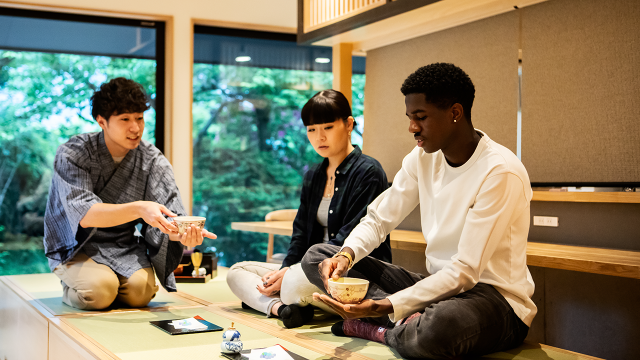
This Pew Research Center analysis explores attitudes on the importance of language, customs and traditions, birthplace, and religion as components of national identity in 23 countries in North America, Europe, the Middle East, the Asia-Pacific region, sub-Saharan Africa and Latin America. National identity is examined in the context of trend data. This is the first year since 2019 that the Global Attitudes Survey has included countries from Africa and Latin America due to the coronavirus outbreak .
The languages and religions we asked about in the survey vary by country and were determined with the input of local survey vendors. Refer to Appendix B for more information on the languages included in the survey and Appendix C for more on the religions included.
For non-U.S. data, this report draws on nationally representative surveys of a total of 24,674 adults conducted from Feb. 20 to May 22, 2023. All surveys were conducted over the phone with adults in Canada, France, Germany, Greece, Italy, Japan, the Netherlands, South Korea, Spain, Sweden and the United Kingdom. Surveys were conducted face-to-face in Hungary, Poland, Indonesia, Israel, Kenya, Nigeria, South Africa, Argentina, Brazil and Mexico. In Australia, we used a mixed-mode probability-based online panel.
In the United States, we surveyed 3,576 U.S. adults from March 20 to March 26, 2023. Everyone who took part in this survey is a member of the Center’s American Trends Panel (ATP), an online survey panel that is recruited through national, random sampling of residential addresses. This way nearly all U.S. adults have a chance of selection. The survey is weighted to be representative of the U.S. adult population by gender, race, ethnicity, partisan affiliation, education and other categories. Read more about the ATP’s methodology .
Here are the questions used for the report, along with responses, and the survey methodology .
Results of a Pew Research Center survey highlight language and customs as key components of national identity, while views on the importance of birthplace and religion are more divided.
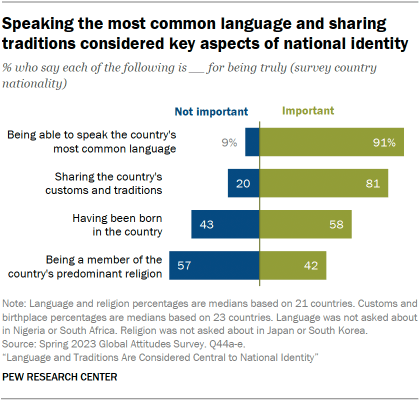
Across more than 20 countries surveyed, a median of 91% say being able to speak their country’s most common language is important for being considered a true national, and 81% say sharing their country’s customs and traditions is important for true belonging. Views on the importance of birthplace and religion to national identity are mixed.
Of the four dimensions of national identity included in the survey, language is by far the most valued. In all countries where we asked about it, about eight-in-ten or more point to language as important for true belonging in the country. And in 13 countries, at least six-in-ten consider it a very important factor. (Explore more views about language in Chapter 1 .)
Participation in a country’s customs and traditions is also valued: Around seven-in-ten or more consider sharing national customs and traditions important for true belonging in most countries. Emphasis on shared customs has declined somewhat since 2016, including by double digits in Germany, Japan and the United Kingdom. (Explore more views about customs and traditions in Chapter 2 .)
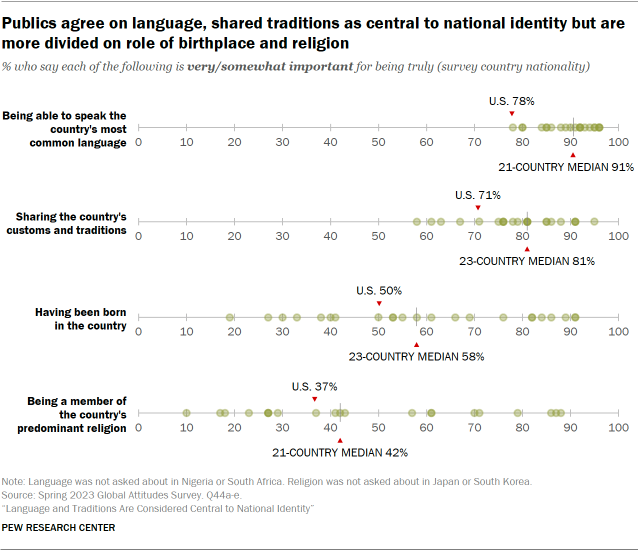
The connection between birthplace and national identity is somewhat weaker. Majorities in about half of the countries say being born there is important for truly belonging. The middle-income countries surveyed place greater emphasis on birthplace than the high-income countries in the study. At least three-quarters in all seven middle-income countries believe being born in their country is important for being considered a true national. Notably, United Nations research has found that middle-income countries are home to a lower share of international migrants than high-income nations. (Explore more views about birthplace in Chapter 3 .)
Views on religion as a component of national identity vary significantly across the nations surveyed, with several middle-income countries especially likely to consider it important. In contrast, fewer than one-in-four think being a member of the predominant religion is important to true belonging in the high-income countries of Australia, France, Spain and Sweden. (Explore more views about religion in Chapter 4 .)
The United States stands out for having the lowest share who say speaking the country’s most common language is important for being a true national (78%). A relatively low share of Americans say the same about participating in the country’s traditions (71%). On the other hand, those in the U.S. place more emphasis on being a member of the country’s primary religion than people in most other high-income countries surveyed (37%). U.S. views on birthplace fall around the middle of the high-income countries (50%).
To compare how many dimensions respondents consider important for true belonging in each country, we created an index based on all four dimensions of national identity included in the survey. Using the index, Indonesians stand out as considering the greatest number of dimensions important for true belonging, while Sweden stands out as the nation with the fewest conditions. (For more information on the index, refer to Appendix A .)
These findings come from a Pew Research Center survey conducted from Feb. 20 to May 22, 2023, among 28,250 people in 23 countries.
Views by political ideology
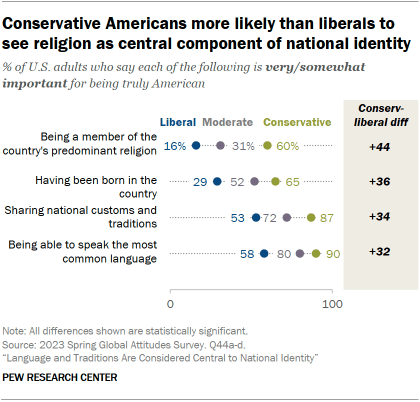
Who counts as a true national is a partisan issue in many countries, and those on the ideological right generally consider more factors important for belonging.
The U.S. sees some of the greatest ideological divides, with conservative Americans at least 30 percentage points more likely than liberals to consider each component we asked about important for being truly American. The gap is most pronounced when it comes to religion: Conservatives are 44 points more likely than liberals to say being a Christian is important for being truly American.
Views by age, education and religion
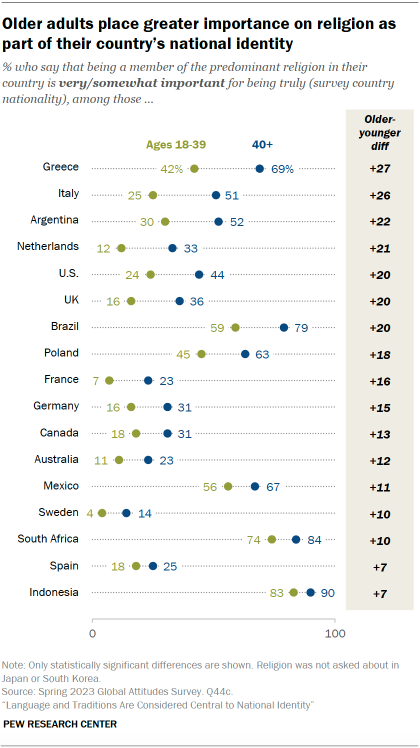
Older adults tend to place greater importance on many of the components of national identity we asked about. The age divide is especially notable in Canada, Germany, Japan, South Korea, Sweden and the U.S., where older adults consider all factors included in the survey as more important for true belonging. For example, Canadians ages 40 and older are at least 10 points more likely than those ages 18 to 39 to label each dimension as important to Canadian identity.
Views also differ between those with more education and those with less. In most countries, those with less education tend to see being born in the country and being a member of the country’s primary religion as important components of national identity. Evaluations of the importance of customs and traditions also vary by education level in some countries, but no differences are present when it comes to the importance of language.
Religious identity is linked to views of national identity. Most, if not all, factors are seen as more important by members of the country’s primary religion in most places surveyed. In comparison, those who do not ascribe to the country’s most common religion place less importance on each factor. For example, in the U.S., Christians are more likely than those of other religious affiliations – including those who are atheist, agnostic or say their religion is “nothing in particular” – to see being Christian, being born in the U.S., speaking English, and sharing U.S. customs and traditions as important for being truly American.
Sign up for our weekly newsletter
Fresh data delivery Saturday mornings
Sign up for The Briefing
Weekly updates on the world of news & information
- Immigration & Language Adoption
- Integration & Identity
- International Affairs
- International Political Values
- Racial & Ethnic Identity
- Religious Identity & Affiliation
Cultural Issues and the 2024 Election
How hispanic americans get their news, latinos’ views of and experiences with the spanish language, 5 facts about arabic speakers in the u.s., in their own words: asian immigrants’ experiences navigating language barriers in the united states, most popular, report materials.
1615 L St. NW, Suite 800 Washington, DC 20036 USA (+1) 202-419-4300 | Main (+1) 202-857-8562 | Fax (+1) 202-419-4372 | Media Inquiries
Research Topics
- Email Newsletters
ABOUT PEW RESEARCH CENTER Pew Research Center is a nonpartisan fact tank that informs the public about the issues, attitudes and trends shaping the world. It conducts public opinion polling, demographic research, media content analysis and other empirical social science research. Pew Research Center does not take policy positions. It is a subsidiary of The Pew Charitable Trusts .
© 2024 Pew Research Center
Society News

RNC’s New Abortion Stance Betrays GOP’s Founding, Pro-Life Activist Says
Politics News

Advertising Giant GARM Illegally Censored Conservative Outlets, House Report Finds

Immigration Limits Needed to Preserve ‘National Identity,’ Ramaswamy Says

House Passes Measure to Stop Noncitizen Voting in Federal Elections
Law News

House GOP Faces Down Biden Veto Threat on Halting Noncitizen Voting
Politics News

Heritage Action Scores SAVE Act as Key Vote
Security Analysis

It’s Not ‘If’ It Will Happen Again, ‘But When,’ Sheriff Says of Lives Lost to Criminal Illegal Aliens
Politics News

Democrats’ Support for Biden Crumbles
Security Commentary

Ignoring Warnings, Beijing Escalates Aggression Against Philippines
Security Commentary

EXCLUSIVE: 4 Years Later, CDC Documents on COVID-19’s Origin in China Emerge as Oversight Wanes
International Commentary

China’s Maritime Gamble: A Departure From Gray-Zone Coercion in East Asia
Law News

3 Republican Senators Talk Weaponization of Government
Society News

Time to Take Down the Pride Flags and Put ‘In God We Trust’ on Every Federal Building, Sen. Josh Hawley Says

Garland, Clarke, Willis Possible Targets for Conservative Lawfare

EXCLUSIVE: Concerned Women for America Launches ‘She Prays She Votes’ Bus Tour
Security News

EXCLUSIVE: Poll Reveals Gender Divide on Proposal to Include Women in Military Draft

‘ABUSE OF POWER’: Texas Dad Suing for Retaliatory Arrest Reveals New Evidence of Corruption

EXCLUSIVE: Women’s Group Calls Military Draft Proposal ‘Unacceptable’
Education News

NYU Settles Lawsuit With Jewish Students Over Campus Antisemitism
International News

US to Scrap Biden’s Problem-Ridden Gaza Pier for Good

Fact-Checking 17 Claims in First Biden-Trump Debate
Education Analysis

Parents Defending Education Adviser Explains ‘Anti-Woman,’ ‘Anti-Girl’ Title IX Reinterpretation
Health Care Analysis

‘It’s Going to Be Catastrophic’: Why the Next Pandemic Will Be Worse Than COVID
Security Analysis

US Enemies See ‘Invitation to Aggression’ After Biden’s Debate Performance, Foreign Policy Expert Says
Society Commentary
As an Asian American, I Say DEI Must Go
Contrary to its proponents' claims, under DEI, some are more equal than others. (Lindsey Nicholson/UCG/Universal Images Group/Getty Images)
As someone who was involuntarily used as a poster child for Asian American and Pacific Islander month by my university, yet listened to some classmates rant that Asian Americans “would be nowhere without black people,” take it from me: Diversity, equity, and inclusion offices make racism worse, not better.
Nobody should wonder whether circling their race on an application form would harm his or her chances of being accepted, yet I would be lying if I said that was not my first thought every time I reached the dreaded racial question.
What else can you expect when your racial identity—an immutable trait that is literally skin-deep—signals to a university or workplace that you are “too privileged” or less deserving to have a seat at the table?
Conversely, how could one’s race alone fairly make someone more deserving of admittance?
I will never forget my senior year of high school, when I consulted a pro-DEI teacher about my essay topic for the Common App to colleges.
She squinted at my face before asking, “Have you given much thought to writing about your race in your college essay? I mean … ’cause you’re clearly not white.”
My heart sank. Suddenly , I went from being an impressive writer to another non-white person whose race needed to be exploited for sympathy.
Little did my teacher know that I am half white and half Asian, two of the DEI scorecard’s least favorable boxes to check.
To this day, classrooms preach inclusivity in the same breath that they write white people off as privileged and cultureless. The more an individual is “white-passing,” the less interesting they become.
This narrative is poisoning minds in grade school and higher education. Take the “model minority” stereotype about Asians, which asserts that Asians are successful because their culture uniformly pressures them to perform well.
Stereotypes such as these have been perpetuated by DEI under the guise of being inclusive when it is anything but. It treats people as groups defined by distinct levels of oppression, instead of rewarding people based on merit .
In late May, former Harvard University President Claudine Gay was honored with a Faculty Award and called “our forever president” at a separate graduationfor black students, not due to her research, but because of her “commitment to social justice.”
Meanwhile, Harvard’s DEI office, which Campus Reform reports sponsored the ceremony, has not commented on Gay’s inability to state unequivocally before Congress that calling for the genocide of Jews violates Harvard’s policies.
I may be biracial and have Asian heritage, but that identity has no bearing on my most important and fulfilling identities: child of God, daughter of two great parents, proud sister, and friend to many.
It certainly has no bearing on my ability to seek opportunities and try my best.
Anyone who says otherwise is evidence that DEI offices profit from teaching people to judge others by their skin color , rather than their character.
Character cannot be built by meeting racial quotas. It’s developed through taking risks and working hard.
Contrary to what the Left would have you believe, the ability to grit your teeth and work hard to pursue your dreams is not exclusive to “white-passing” people.
This fact is liberating, and anything but oppressive or racist.
What is unacceptable is impeding someone’s potential to learn or succeed because they do not check a favorable racial box, not to mention doing so under the guise of being against racism.
Last year, the Supreme Court’s decision to overturn race-conscious admissions to colleges and universities marked a celebratory step for fairness.
But it isn’t enough. State lawmakers in Alabama, Florida, Indiana, Iowa, Texas, and more are prohibiting the use of taxpayer spending on racist DEI programs at colleges. Policymakers around the country frustrated by the student “encampments” on campuses this spring that claimed to be for peace , but were really antisemitic activists , would do well to follow suit.
DEI is a wolf in sheep’s clothing, and it’s time we exposed it as such. Like racial preferences, it too must go.
Related posts:
- Kansas Universities Spent $45 Million on DEI. Lawmakers Want to Know What They Paid For.
- DEI’s Demise: University of North Florida Closes Divisive Department
- Defeating DEI and Rescuing Higher Education
- Alzheimer's disease & dementia
- Arthritis & Rheumatism
- Attention deficit disorders
- Autism spectrum disorders
- Biomedical technology
- Diseases, Conditions, Syndromes
- Endocrinology & Metabolism
- Gastroenterology
- Gerontology & Geriatrics
- Health informatics
- Inflammatory disorders
- Medical economics
- Medical research
- Medications
- Neuroscience
- Obstetrics & gynaecology
- Oncology & Cancer
- Ophthalmology
- Overweight & Obesity
- Parkinson's & Movement disorders
- Psychology & Psychiatry
- Radiology & Imaging
- Sleep disorders
- Sports medicine & Kinesiology
- Vaccination
- Breast cancer
- Cardiovascular disease
- Chronic obstructive pulmonary disease
- Colon cancer
- Coronary artery disease
- Heart attack
- Heart disease
- High blood pressure
- Kidney disease
- Lung cancer
- Multiple sclerosis
- Myocardial infarction
- Ovarian cancer
- Post traumatic stress disorder
- Rheumatoid arthritis
- Schizophrenia
- Skin cancer
- Type 2 diabetes
- Full List »
share this!
July 10, 2024
This article has been reviewed according to Science X's editorial process and policies . Editors have highlighted the following attributes while ensuring the content's credibility:
fact-checked
peer-reviewed publication
trusted source
Writing about identity and values can boost teens' self-esteem
by James Dean, Cornell University

Providing teenagers opportunities to affirm positive aspects of their identities can help bolster their self-esteem over time and ease transitions to high school, new Cornell psychology research finds.
In a study involving nearly 400 ninth graders, students who completed short essays every few months about identities or values important to them reported stable or even improved self-esteem throughout the year, on average. Peers who didn't complete the self-affirmation exercises saw average self-esteem drop significantly—a common phenomenon when starting high school.
The results suggest that in addition to values-based affirmations, which have been studied more extensively, identity-based affirmations could be beneficial at a time when teens are forging and becoming more aware of their identities, said Adam Hoffman, assistant professor in the Department of Psychology and College of Human Ecology.
"Self-esteem is derived from our social identities in some ways, and teens are starting to be shaped by their social identities in adolescence," Hoffman said. "If we can encourage explicit socialization of their identity and frame it in a positive light, we may see better outcomes in mental health and overall well-being."
Hoffman is a co-author of "The Promise of an Identity-Based Self-Affirmation Intervention in Protecting Against Self-Esteem Declines at the High School Transition," published in Developmental Psychology , with Hannah Schacter, assistant professor of psychology at Wayne State University.
Though strong self-esteem is linked to better health and academic performance , it is known to stagnate or decline among adolescents starting high school. At that age, Hoffman said, students are developing a more complex and nuanced sense of self, while navigating new social relationships and being confronted with frequent opportunities to see how they measure up, such as through grades and athletics.
"Adolescents' social cognition enables them to have more realistic self-perceptions and understandings of their abilities, and there are many ways to assess themselves in comparison with others," Hoffman said. "We were interested in finding ways to help mitigate those normatively occurring dips that we see in self-esteem."
Although prior research has focused on how self-affirmations influence academic outcomes, Hoffman said, the new study is among the first to investigate their effects on psychological well-being, specifically self-esteem. Research to date has also overwhelmingly tested more traditional affirmations of values.
To test the benefits of an intervention affirming identities, the researchers recruited a diverse sample of 388 students from 38 schools in Michigan, averaging 14 years old. Participants completed up to five self-esteem assessments during ninth and tenth grade. Starting in the fall of 2020, as ninth graders, they were randomly assigned to one of three groups that completed a series of three writing exercises.
Responding to prompts every few months, participants in one group explained what they liked about an identity, selected from race/ethnicity, religion, sexual orientation, weight, immigrant status, language, disability, socioeconomic status or "other." Another group focused on a value they considered important, such as creativity or sense of humor. And a control group wrote about that day's morning routine.
The results showed self-esteem held steady for the first two groups, but declined over time for the control group , suggesting that the interventions had a "large effect" on average. That was particularly notable since the study took place during the COVID-19 pandemic, when students and adults were experiencing higher levels of stress, though the authors said additional research should be done in more normal conditions.
The scholars had expected to identity-based affirmations to bolster self-esteem the most. But they noted that teens are concurrently developing both identities and values that could protect them when facing increasing academic demands, difficulty with friends or family, or instances of discrimination.
"Perhaps it is not surprising that having repeated opportunities to positively reflect on anything of personal significance to the self—whether that be personal values or social identities—may offer a method for preserving a sense of self-worth," the authors wrote.
Schools, counselors and parents could provide those opportunities with minimal disruption, the scholars said, to help teens feel better about themselves as they transition to high school.
"This is something that could be done in an English class in 10 minutes, a couple of times a year, and it's super-easy and relevant for kids," Hoffman said. "Any type of affirmation intervention, whether it's based on their values or identity, is showing to help with self-esteem ."
Explore further
Feedback to editors

Major trial looks at most effective speech therapy for people with Parkinson's disease

Models show promise in predicting cognitive decline in early Alzheimer's
3 hours ago

New material derived from graphene improves the performance of neuroprostheses
5 hours ago

Discovery could help with early detection of vision loss in age-related macular degeneration

New Co-STAR T cells show promise for treating cancers in laboratory study

Microproteins exclusively produced in liver tumors could lead to cancer vaccines

Scientists demonstrate a combination treatment can increase human insulin-producing cells in vivo

Cognitive skills in early toddlerhood: Study demonstrates importance of 16-months
6 hours ago

Brain region involved in oxycodone relapse identified

Blood cancer drug could make radiotherapy on brain tumors more effective
Related stories.

Positive school climate boosts high school grades, study finds
May 3, 2024

Study finds same-race friends help teens connect to school
May 11, 2022

Q&A: How does self-esteem affects relationships?
Feb 13, 2024

What we get wrong about self-esteem: It's built through actions, not words
Aug 16, 2023
Timing of maturity, feelings about ethnicity and race can positively affect black males' self-concept, well-being
May 5, 2020

Making mural art helps teens cope
Apr 9, 2024
Recommended for you

New form of repetitive magnetic brain stimulation reduces treatment time for bipolar disorder
8 hours ago

Creativity starts in the cradle, new research shows
9 hours ago

Living in poverty due to mental health problems or developing mental health problems because of poverty? It's both
14 hours ago

Dental visits found to increase with support from pediatric providers

New study reveals high rates of missed GP appointments among patients with ADHD
Jul 9, 2024
Let us know if there is a problem with our content
Use this form if you have come across a typo, inaccuracy or would like to send an edit request for the content on this page. For general inquiries, please use our contact form . For general feedback, use the public comments section below (please adhere to guidelines ).
Please select the most appropriate category to facilitate processing of your request
Thank you for taking time to provide your feedback to the editors.
Your feedback is important to us. However, we do not guarantee individual replies due to the high volume of messages.
E-mail the story
Your email address is used only to let the recipient know who sent the email. Neither your address nor the recipient's address will be used for any other purpose. The information you enter will appear in your e-mail message and is not retained by Medical Xpress in any form.
Newsletter sign up
Get weekly and/or daily updates delivered to your inbox. You can unsubscribe at any time and we'll never share your details to third parties.
More information Privacy policy
Donate and enjoy an ad-free experience
We keep our content available to everyone. Consider supporting Science X's mission by getting a premium account.
E-mail newsletter
- About University Overview Catholic, Marianist Education Points of Pride Mission and Identity History Partnerships Location Faculty and Staff Directory Social Media Directory We Soar
- Academics Academics Overview Program Listing Academic Calendar College of Arts and Sciences School of Business Administration School of Education and Health Sciences School of Engineering School of Law Professional and Continuing Education Intensive English Program University Libraries
- Admission Admission Overview Undergraduate Transfer UD Sinclair Academy International Graduate Law Professional and Continuing Education Campus Visit
- Financial Aid Affordability Overview Undergraduate Transfer International Graduate Law Consumer Information
- Diversity Diversity Overview Office of Diversity and Inclusion Equity Compliance Office
- Research Research Overview Momentum: Our Research UD Research Institute Office for Research Technology Transfer
- Life at Dayton Campus Overview Arts and Culture Campus Recreation City of Dayton Clubs and Organizations Housing and Dining Student Resources and Services
- Athletics Athletics Overview Dayton Flyers
- We Soar We Soar Overview Priorities Goals Impact Stories Volunteer Make a Gift
- Schedule a Visit
- Request Info
Explore More
- Academic Calendar
- Event Calendar

- Online LL.M. Mini Bar Prep Course
- LL.M. & M.S.L. Programs
Get an Inside Look at Our Mini Bar Prep Course — offered exclusively and free of charge for Dayton Law Online LL.M. Graduates
Expertly designed by the University of Dayton School of Law’s Director of Bar Preparation, Associate Professor Tommy Sangchompuphen , our mini bar prep program supplements our graduates’ LL.M. studies and their commercial bar prep course to put them in the best position to succeed on the bar exam. It offers additional dedicated and customized support for our Online LL.M. graduates and equips them with the knowledge, exam skills, and confidence needed to conquer the challenge.
Get a FREE sample of 5 real resources our students can access to prepare for bar exam success. Check out some of the strategies and insights that give our graduates a head start on their journey:
- Daily Breakfast Bar — Get a glimpse of the daily content our students receive, including helpful bar exam tips, advice, events, and more to keep them on track and at the top of their game throughout their months of preparation.
- Bar Chart — Streamline learning with our flowcharts and other visual aids, designed to break down complex legal concepts so that students can understand important connections.
- MEE Testing History — See how we’ve researched every essay on the Multistate Essay Examination since 2008, providing students with a focused approach by documenting the most commonly tested concepts. This method not only reduces students’ study load but also enhances memorization of rule blocks, accelerates issue identification in essays, and boosts confidence with each exam question answered.
- Workshop Short Clip — Watch a clip from one of our hour-long workshops on the “dying declaration,” one of several exceptions to the hearsay rule, where we hone in on the areas where examiners may most likely focus.
- Marked-up Essay — Review an actual marked-up essay demonstrating the type of individualized feedback students receive. This detailed critique is designed to help students incorporate suggestions into their next assignment, fostering continuous improvement and better performance on the bar exam.
Sign up now to access 5 examples and receive our Online LL.M. program newsletter!
Sign Up To Sample Our Online LL.M. Mini Bar Prep Course
Please fill out the form below to receive 5 examples from our Mini Bar Prep Course and be added to the list to receive our Online LL.M. program newsletter.
Online LL.M. Program
Advertisement
Supported by
Read Your Way Through Prague
Prague has survived wars and political strife — and through it all, its literary scene has thrived. Jaroslav Kalfar, the author of “Spaceman of Bohemia,” recommends books that connect readers to the city.
- Share full article

By Jaroslav Kalfar
Read Your Way Around the World is a series exploring the globe through books.
Few could doubt the literary bona fides of the Czech Republic, a country that elected a dissident playwright, Vaclav Havel, as its first post-Communist president. Literature is at the center of the Czech heart because it created us and liberated us.
As Austria-Hungary strove to make us German, writers and poets worked to create and preserve the idea of Czech language and national identity. When the Communist Party fought to purge intellectual rebellions, dissidents met in Prague’s legendary smoke-filled pubs to discuss and smuggle their banned work through the samizdat network .
Famously, Prague , known as the City of a Hundred Spires, was the foremost muse for the troubled mind of one Franz Kafka, despite his uneasy relationship with the city. (Communist authorities tried to erase Kafka from Czech history for decades .)
While Prague hasn’t escaped the commercialization befalling many European metropolises — Gothic cathedrals now share space with luxury fashion brands and golden-arch fries — its literary life cannot be snuffed out. Literature and myth live in every cobblestone, leading down narrow alleyways in the city’s Old Town toward medieval alchemic mysteries, techno parties in centuries-old basements and astronomical clocks tracking the paths of stars.
What should I read before I pack my bags?
The secret to Prague’s lasting beauty is as arbitrary as it is straightforward: Neither the Allies nor the Axis felt the need to destroy the city during World War II. Prague held on to its shimmering rooftops and medieval bridges built by Holy Roman emperors. Though war didn’t change the city’s looks, it did reshape the soul of its people.
The protagonist in Jaroslav Hasek’s novel “The Good Soldier Svejk” is greasing his rheumatic knees in a Prague apartment when the news of Archduke Franz Ferdinand’s assassination reaches his ears. Svejk had been let go from the army when he was officially certified as an idiot, but the outbreak of World War I hurls him into the conflict. Around one million Czechs fought for Austria-Hungary, often with little understanding of why they should risk lives on the empire’s behalf. The loss of individuality to conflict is at the heart of the Czech experience: a country trying to build, constantly usurped by its larger neighbors.
We are having trouble retrieving the article content.
Please enable JavaScript in your browser settings.
Thank you for your patience while we verify access. If you are in Reader mode please exit and log into your Times account, or subscribe for all of The Times.
Thank you for your patience while we verify access.
Already a subscriber? Log in .
Want all of The Times? Subscribe .

IMAGES
COMMENTS
Short Essay on Our Culture Our Identity in 200 Words. The line ' Our culture our identity' comes from the country Nepal. Nepal is a land of diversity. It has various types of flora, fauna, festivals, food, dresses, and culture. But now this is applicable to every country living on Earth. Culture is a part of our identity.
Writing essays about culture and identity will help you explore your understanding of it. Here are examples that will give you inspiration for your next essay.
There comes a huge role of culture to shape the person's identity. Culture contains languages, costumes, food, literature and social activities. They decide what a person is today and will be in future. Culture provides hints for a person to guide his life. The culture each person lives in reveals how to dress, talk, act, acceptable behavior ...
Before starting off with a cultural identity essay, it is fundamental to uncover what is particular about this type of paper. First and foremost, it will be rather logical to begin with giving a general and straightforward definition of a cultural identity essay. In essence, cultural identity essay implies outlining the role of the culture in defining your outlook, shaping your personality ...
Writing a short essay on "Our Culture, Our Pride" is a meaningful way to reflect on and celebrate the unique aspects of one's cultural heritage. This topic invites discussion on the significance of culture in shaping individual and collective identities, and how cultural pride can contribute to a more inclusive and respectful society.
We are Sharing an Essay on Our Culture is Our Pride in English for students and children. In this article, we have tried our best to provide a short Our Culture is Our Pride Essay in 100, 150, 200, 300, and 500 words.
Stuck with writing "how has your culture influenced who you are" essay? Read our self and culture relationship essay to get inspiration for your own personal identity paper.
View our Cultural Identity essay examples to understand how to write about your life experiences. You can also download 📝 these papers.
These cultural identity essay topic ideas and examples offer a wide range of options for exploring the intricate aspects of cultural identity. Remember to choose a topic that resonates with your personal experiences, interests, and perspectives.
Identity is a multifaceted concept that defines who we are as individuals. It is shaped by our experiences, values, beliefs, and how we perceive ourselves in the context of society. In this essay, I will delve into the concept of identity and how it can be defined both personally and socially. I will then analyze an aspect of my personal identity and discuss how it has influenced my ...
Culture is an intricate tapestry woven from the threads of history, geography, language, religion, customs, and shared experiences. It is the soul of a community, the collective memory of a people, and the defining characteristic that sets us apart in the vast human mosaic. Our culture is our pride, a manifestation of our identity and the root of our existence.
Read our crash-course guide on writing an essay about culture with basic dos and don'ts, actionable tips, and topic suggestions on various essay types.
My Cultural Identity: Who I Am. Culture identity has a lot to do with mental health and how you are raised up. So, having the ability to be able to identify with culture benefits and makes the knowledge of humans stronger and able to relate to more people and interact and form groups with those in the same culture as them.
This guide on how to write a cultural identity essay covers the main principles of organizing such papers with explanations and examples.
Do you need to write an essay about your culture but don't know where to start? You've come to the right place! I'm Constance, and I'll show you how to write an essay about your culture. I'll guide you step by step, and we'll write a sample essay together. Let's dive in.
Specifically, the way in which culture shapes one's attitude towards specific phenomena and the perception of specific standards, ethical and moral ones notwithstanding, is a clear-cut manifestation of culture-shaping identity. For example, a certain attitude towards homosexuality within a society is an obvious effect of culture on people's ...
How we see ourselves shapes our lives, and is shaped by our cultural context. Self-perceptions influence, among other things, how we think about the world, our social relationships, health and lifestyle choices, community engagement, political actions, and ultimately our own and other people's well-being. Social scientists have long understood ...
Culture is the most significant identity of human beings. So, knowing own culture is very much important. In this video today, you will learn how to write an essay on the popular phrase: Our ...
Culture is important for several reasons. Firstly, it is a source of pride, allowing us to celebrate our heritage and to express our individuality. Secondly, culture provides us with a sense of identity and belonging, helping us to feel connected to our past and future generations. Finally, culture is a way for us to connect with others who ...
Your culture identity is ultimately the group of people that you feel that you identify with. The thought process behind this is known as cultural identity theory. To get a better idea of this, take a look at this single paragraph blurb of information that you might see in a culture identity essay.
#culture #essay #preparestudies #handwriting #english Write a short essay on Our Culture our IdentityWrite a short essay on Work is Worship : https://youtu.b...
My cultural identity represents who I am as a person and who my family is. My family are my role models for my cultural identity. Even through some off the things they are stereotypical for males and females I would like to share some of the things that represent our cultural identity.
In a study involving nearly 400 ninth graders, students who completed short essays every few months about identities or values important to them reported stable or even improved self-esteem throughout the year, on average.
Our Culture: Our Identity. 39.4K 65 53. by Galekse. Our Culture Is Our Identity. Every person has their own unique identity and culture. Culture plays a huge role to shape our identity. A person's beliefs and morals are made up by the culture and they remain throughout the life of a human being. Culture is what makes a person who he/she is ...
Across more than 20 countries surveyed, a median of 91% say being able to speak their country's most common language is important for being considered a true national. And 81% say sharing their country's customs and traditions is important for true belonging.
DEI perpetuates racism instead of ending it, says someone who experienced it firsthand. The focus on racial identity trumps individual merit.
In a study involving nearly 400 ninth graders, students who completed short essays every few months about identities or values important to them reported stable or even improved self-esteem ...
Workshop Short Clip — Watch a clip from one of our hour-long workshops on the "dying declaration," one of several exceptions to the hearsay rule, where we hone in on the areas where examiners may most likely focus. Marked-up Essay — Review an actual marked-up essay demonstrating the type of individualized feedback students receive. This ...
The story is a mad dash through our chaotic 20th century, when Prague changed radically — and yet, not at all — leaping from empire to democracy to fascist occupation to communism and, finally ...